With a strong, abundant water source provided by the Sebasticook River, an ample work force available and town officials willing to make the necessary concessions to attract a large new business, industrial expansion on a formidable scale was an inevitable destiny.
*
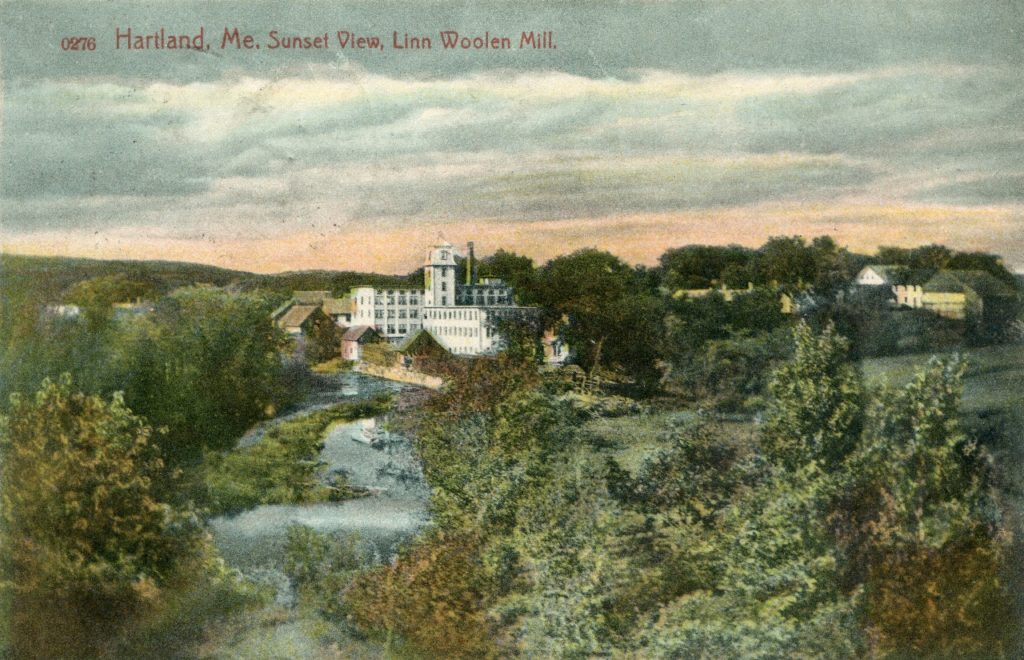
Linn Woolen Mill from Pittsfield Avenue – c1910
*
There were numerous small industrial businesses located throughout Hartland Village and in the outlying areas of North Hartland & West Hartland since the early settlement of the region. They included several sawmills, blacksmith shops, gristmills, brick foundries, a shoe shop and a carding mill, among others. All of them provided important contributions to the overall growth and prosperity of the town however most operated with just a handful of employees with none of them employing more than a dozen people or so.
By the mid-1800s, new production techniques and advancements in technologies were being utilized by the industrial sector including an efficient harnessing of steam power which in turn relied on a steady water source. Industrial expansion on a larger scale was inevitable in the Village with a strong water source provided by the Sebasticook River, an ample work force and town officials willing to work with a new industry.
*
In 1860, businesses located around the Lower Dam area on Main Street included a sawmill (S.M.) located at the original William Moor Sawmill site, a Gristmill (G.M.), the John Page Tannery, 3 Blacksmith Shops (B.S.S.), the Stinchfield Carding Mill and The Park House further up the street. Commercial Street (then known as North Street) was home to just a dozen or so residences, a carriage shop and a single general store on the corner of Main Street.
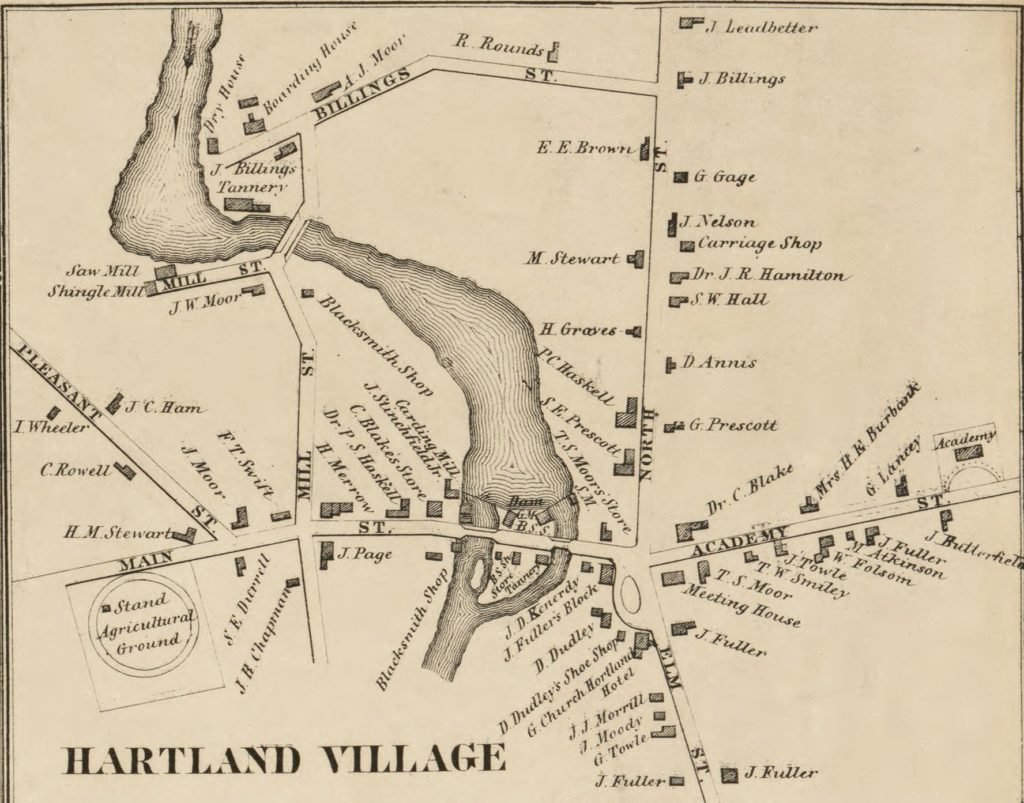
Hartland Village – 1860
(See Maps page for a complete and enlargeable 1860 Map)
*
Linn Woolen Mill | 1864-1889
Archibald Linn (1818-1889) was born in Biggar, Scotland where he was raised and educated. He married Grace Wilson in 1842 and they moved to her native town of Galashiels, Scotland where 3 children were born to them; Christiana, Robert & Thomas, who died as a young child. He engaged in the woolen mill business in Galashiels before he left Scotland for America with Grace and their 2 surviving children arriving in Boston by ship on June 9, 1848. He worked at woolen mills in Cherry Valley, Saugus and Lawrence, Massachusetts for the next 10+ years where 3 more children were born to them; Thomas, Mary & William.
In the late 1850s, Linn came to Dexter where he co-owned and operated an existing woolen mill with David Campbell, also a native of Galashiels, which had been built in 1846 (future Fay-Scott location). As noted in the 1860 Census, Archibald was still residing in Lawrence, Massachusetts in June of 1860 with Grace and their children before moving the family to Dexter where their youngest child William Linn passed away in May of 1863 at 3 years old followed by the death of their oldest daughter Christiana Linn in August of 1863 at 20 years old leaving Robert Wilson Linn, Thomas Archibald Linn & Mary Isabelle Linn as their only surviving children.
*
Around 1863, Archibald Linn came to Hartland where he found conditions quite suitable to build and operate his own woolen mill business including a prime location along the Sebasticook River and 3 year tax abatement offering by the town. As reported by a local newspaper, Linn began building the new mill in late 1863 next to the Lower Dam on Main Street encompassing the site of the original sawmill off Commercial Street which had been constructed by William Moor around 1798.

Bangor Daily Whig & Currier – November 16, 1863
*
The timing of the new woolen mill’s construction coincided with the ongoing Civil War providing Linn an opportunity to garner a lucrative contract from the government to produce ‘Union Blue’ wool and the new mill prospered greatly. With the completion of his new mill in Hartland in 1864, Linn sold his business shares in the Dexter Woolen Mill to Mr. Campbell. Linn later purchased and operated the existing grist mill located next to his new building.
*
Early publications and newspapers often referred to the company as the Sebasticook Woolen Mill of Hartland, Maine into the mid-1870s. It is currently unknown if the business name was officially changed to the Linn Woolen Mill but all further documents after that time period refer to it as the latter.
![]()
Woolen Mill Industry Publication
*
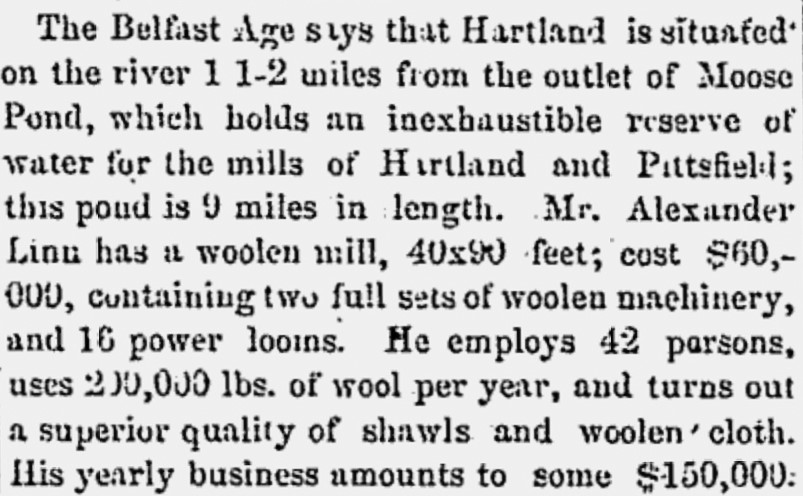
February 24, 1868
*
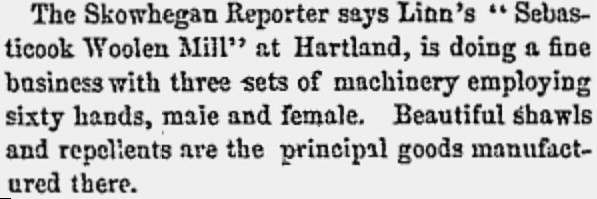
November 16, 1869
An 1869 letter from a correspondent in Hartland to The Portland Daily Press concerning several of the town’s industries also included several details about the woolen mill as well as another general reference to when it was built.
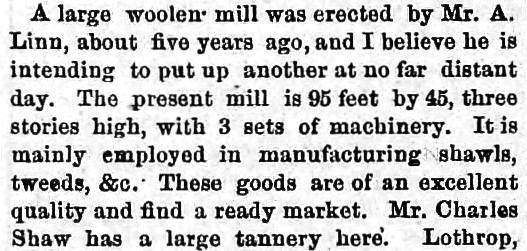
The Portland Daily Press – April 29, 1869
*
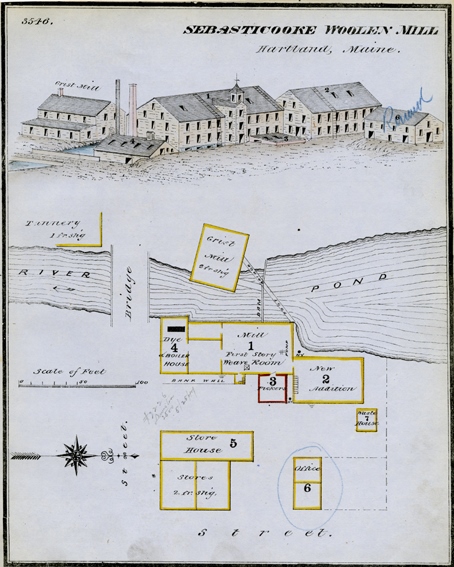
Insurance Company Rendering of Linn Woolen Mill – 1874
(Photo courtesy of American Woolen Mill Museum, Ohio)
*
The new mill dramatically changed the landscape of Main Street as well as inducing several new store businesses to open in the village. Fire fighting equipment owned by the Linn Woolen Mill was shared by the town’s volunteer fire department and was stored under lock & key at the mill. It was a convenient arrangement until a massive weekend fire at the Fuller-Buck Store at Warren Square in late 1878 forced the town to rethink its equipment and storage strategy when its firefighters were unable to access the equipment locked up at the mill in time to save the building. In 1879, the town built a dedicated Fire Hall on Water Street with its own fire equipment.
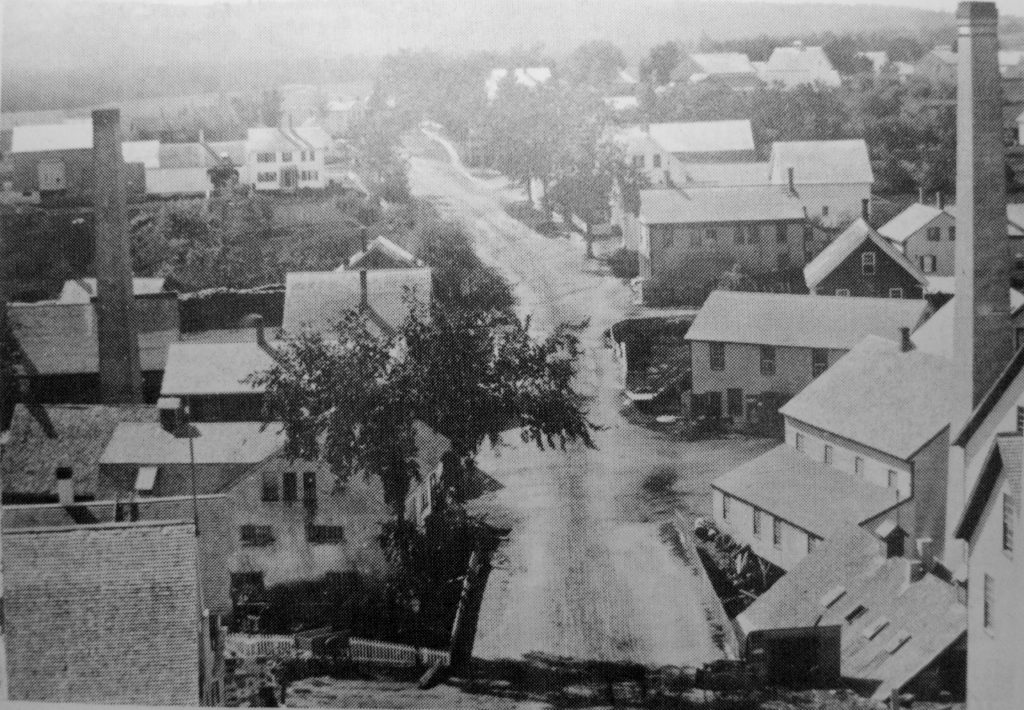
Front of Linn Woolen Mill (right w/chimney) & Grist Mill looking West on Main Street from Baptist Church Steeple – c1877
*
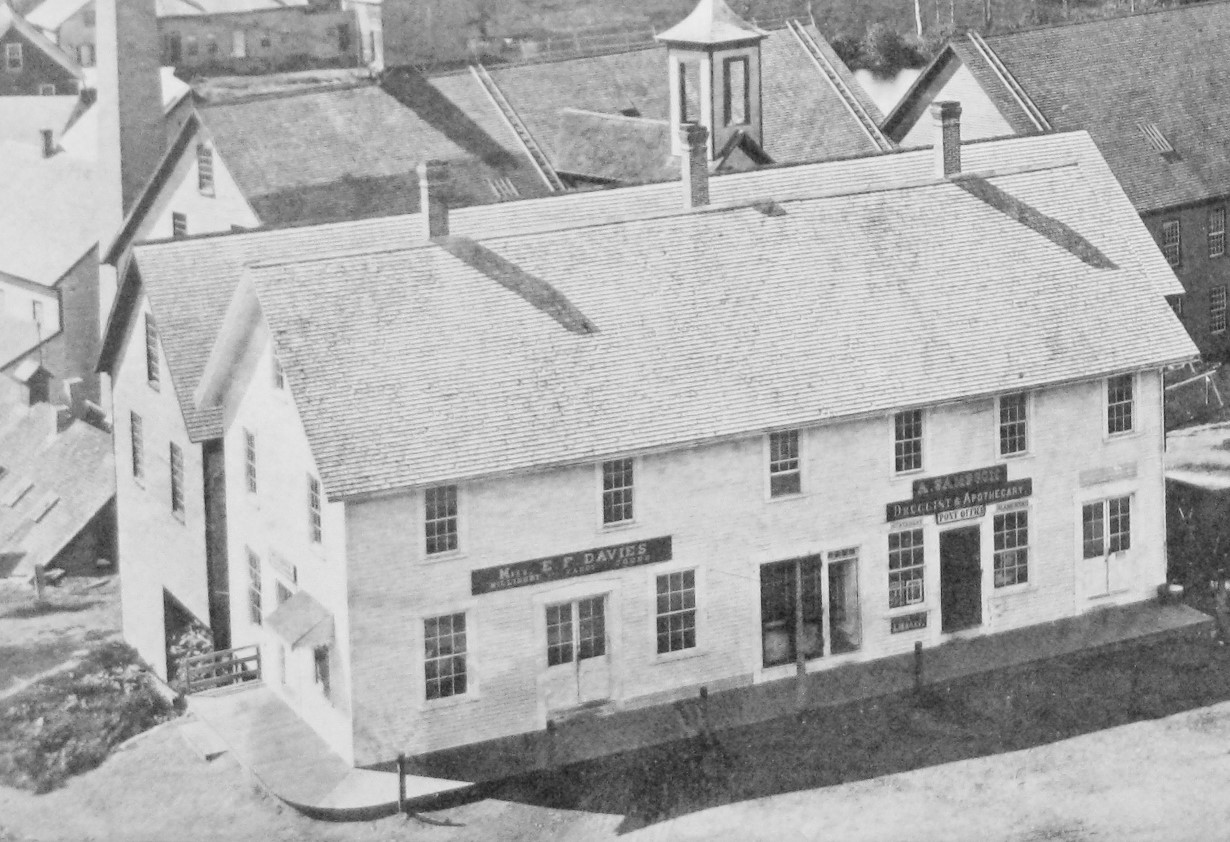
Linn Woolen Mill seen behind Drug Store from Baptist Church Steeple – c1877
*
The original Linn Woolen Mill seen across the river from the future Hubbard Avenue with its peaked roof over 3 floors along with the catwalk seen crossing to the Grist Mill as drawn in the 1874 insurance rendering above.
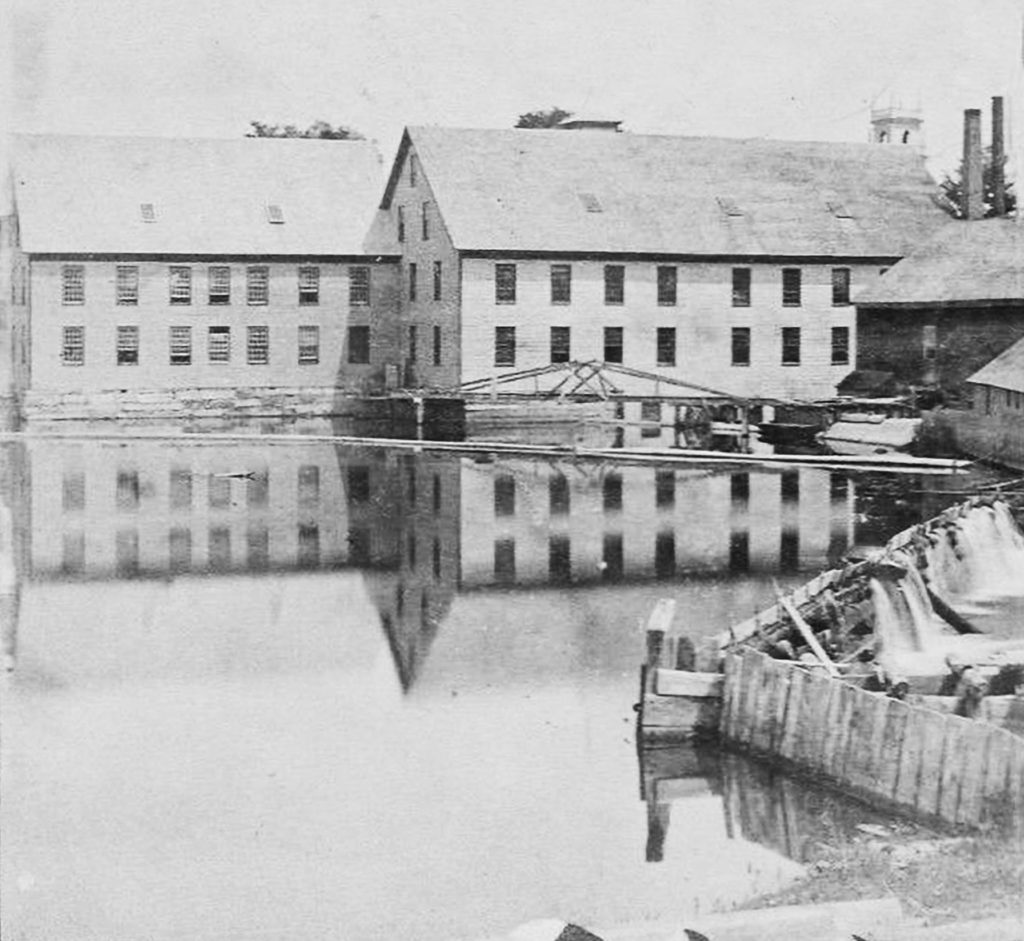
Original Linn Woolen Mill – c1877
*
In the 1890’s, its more familiar flat roof was added to the rebuilt 3rd story of the original building.
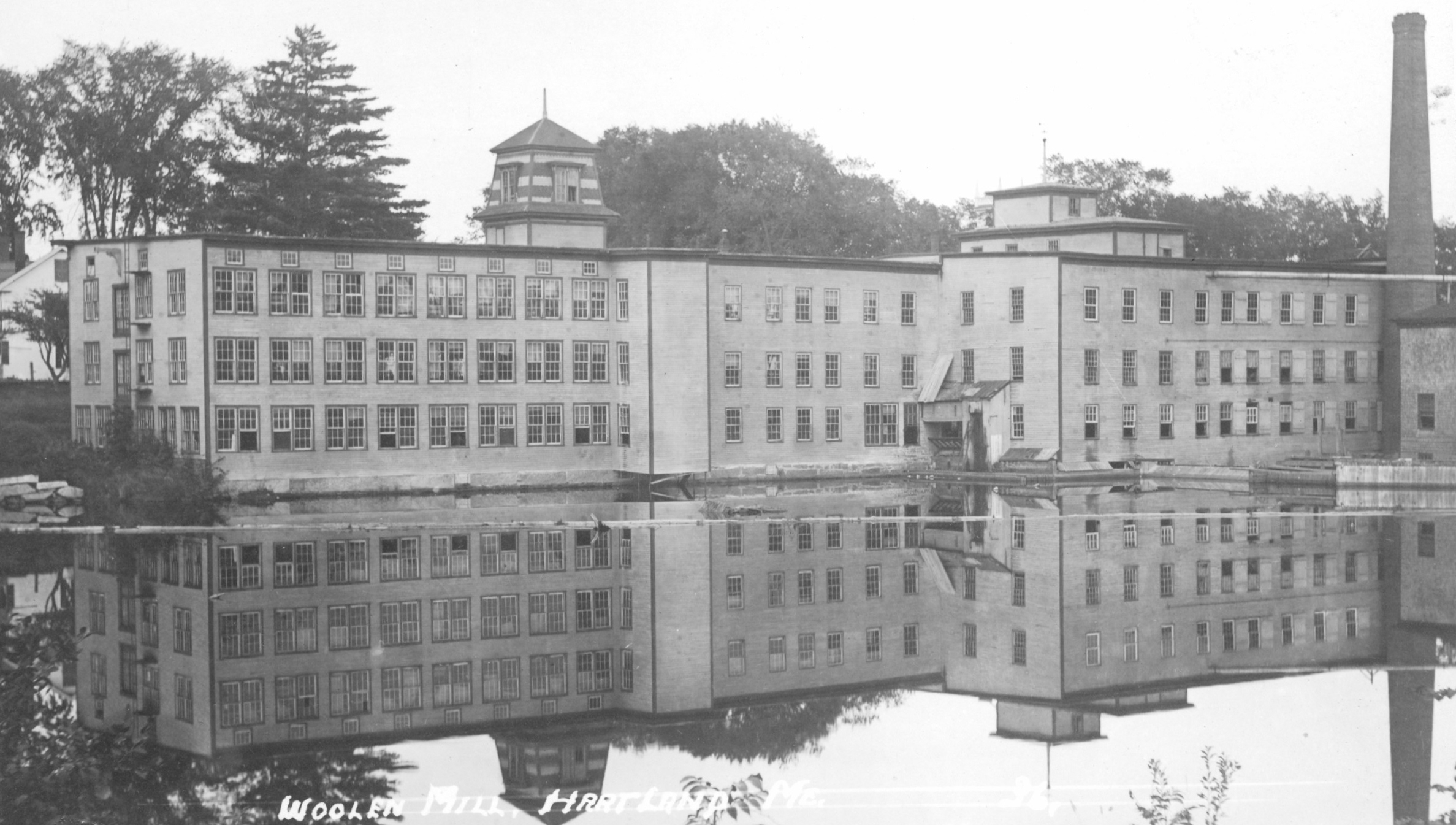
Remodeled Linn Woolen Mill – c1915
*
Upon moving to Hartland, Archibald & Grace purchased the house below on Commercial Street from Sewell E. Prescott where they resided for the rest of their lives. The house was originally owned by Sewell’s father, Sewell Prescott, Sr, who had moved to Hartland from Monmouth in the early 1820s.
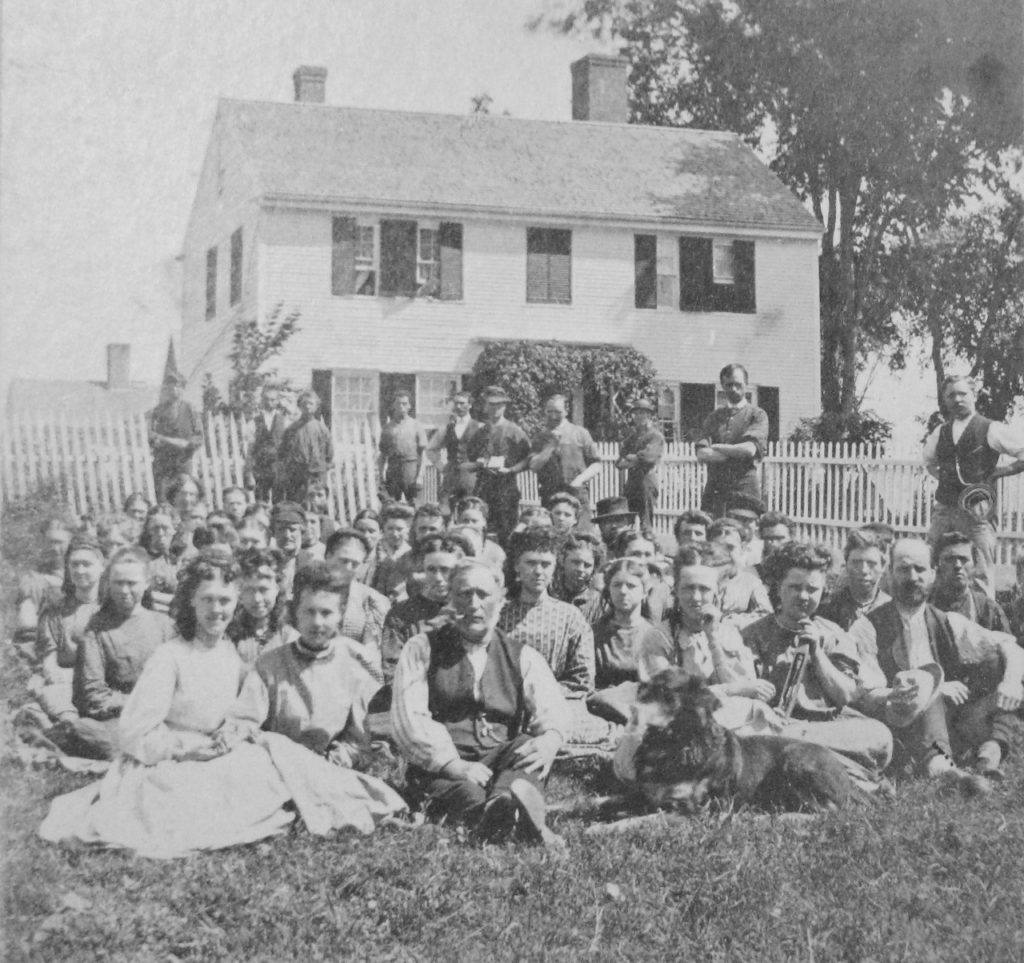
Archibald Linn (center) hosting Linn Woolen Mill Employees at his Commercial Street Residence
*
Archibald & Grace Linn were known for their numerous social gatherings at their home including those with family, friends or employees.
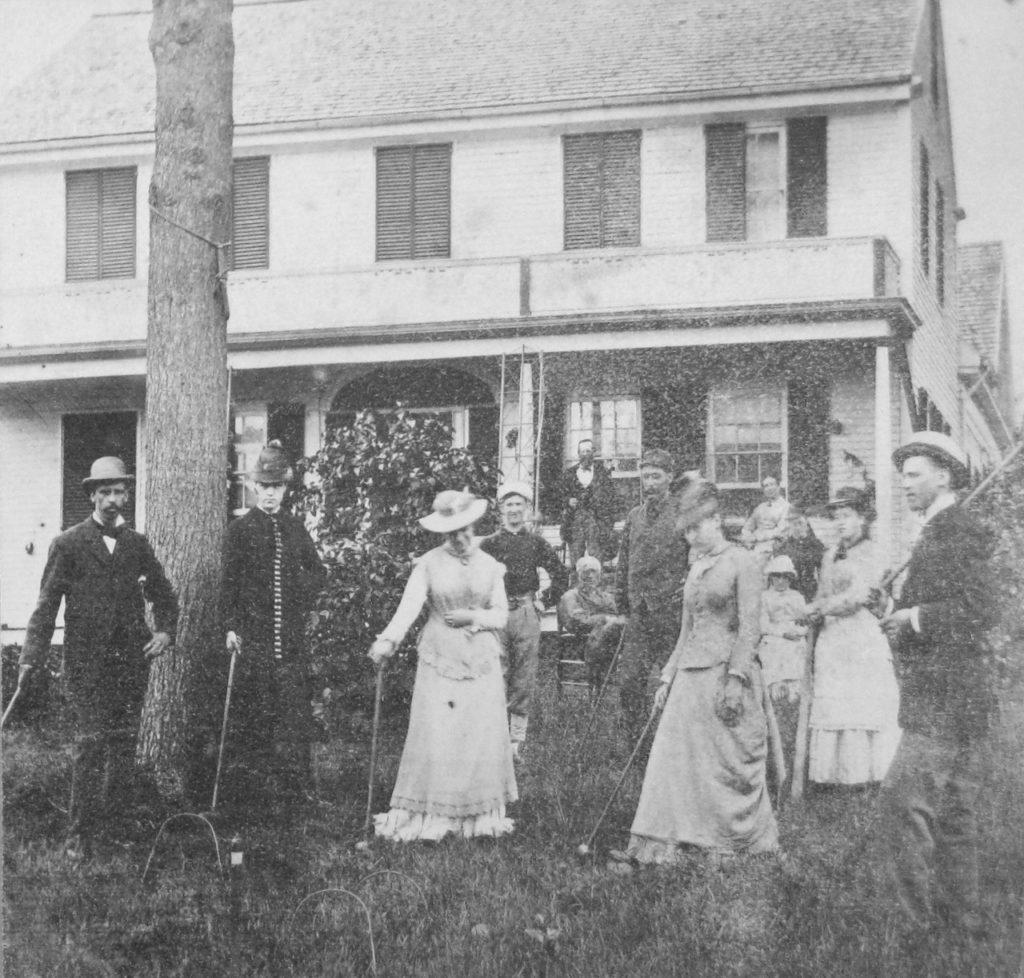
Family & Friends at the Linn Residence on Commercial Street
*
Archibald Linn’s business, real estate and political interests were vast. Along with his successful woolen mill business, he also operated a grist mill and granite quarry. He was a Maine State Senator in 1879-’80 and played a leading role in bringing the Sebasticook & Moosehead Railroad to Hartland in 1886. Linn purchased numerous houses and real estate in Hartland, much of which would later be sold in the Great Auction of 1932. He also donated some 900+ acres of his large land holdings in Harmony on Great Moose Lake for the Wild Goose Club’s Castle Harmony complex built in 1872.
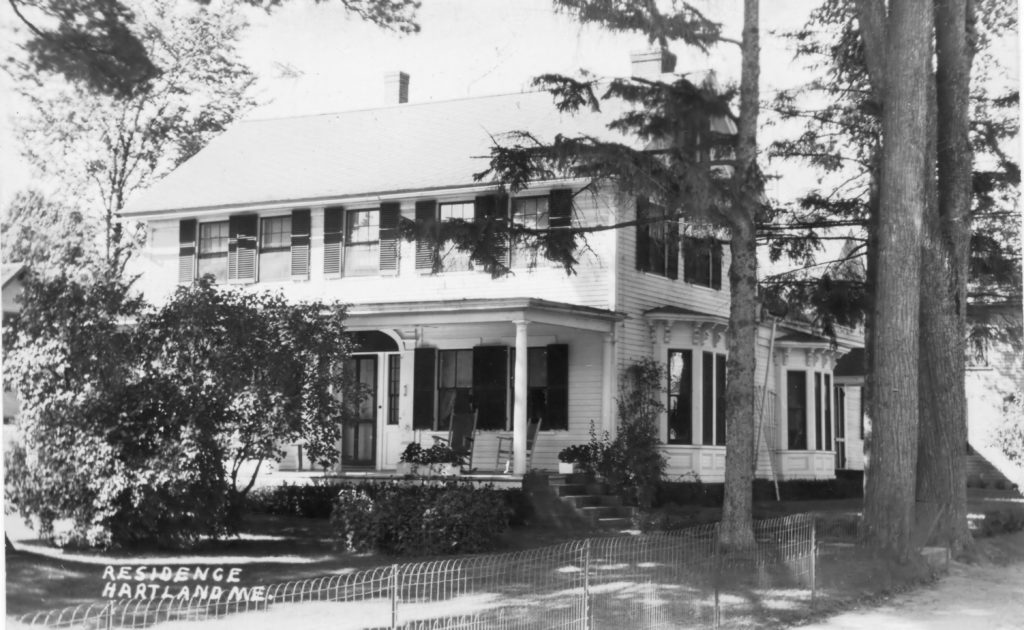
Former Archibald & Grace Linn Residence as later owned by Elmer Burton – c1940
*
Work conditions at the woolen mill or any factory in these times were particularly dangerous. Workers performed their tasks under minimal natural light from windows and a few gas lights. There were unprotected drive belts and open machinery parts with numerous accidents reported over the years. One particular deadly accident was reported in the Bangor Whig newspaper as noted:
February 23, 1878: “Isaiah Woodbury (III) was instantly killed on Saturday in Lynn’s Woolen Mill in Hartland, being caught in a belt.”
March 2, 1878: “The reporter says that Mr. Isaiah Woodbury (II), father of the young man who was killed at Linn’s Mills in Hartland, was at work in the woods at the time of the accident, and on the same day had a presentiment of his son’s death. The effect upon his mind created considerable alarm among the men at work with him. He left his work and arrived at his home just as the messenger came to communicate the sad intelligence of his son’s death.”
Isaiah Woodbury III was 36 years old at the time of his death. He was born in Hartland in 1841, the son of Isaiah Woodbury II & Mary “Polly” Cook. He was a Civil War Veteran and had married Mary Nevens. Their daughter Adeline Woodbury would marry Allen R. Burton who would later operate “A. R. Burton & Son” store on Commercial Street.
*
Young women made up a large portion of the work force at the Linn Woolen Mill.
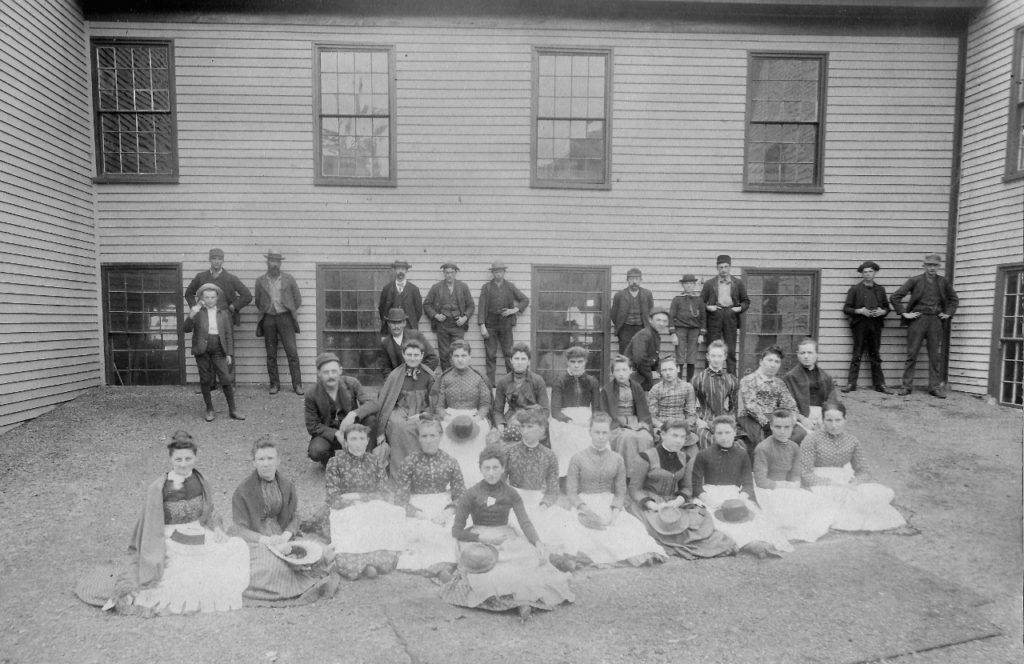
Linn Woolen Mill Workers – c1877
*
Along with the new woolen mill, Linn also built a storage building on Main Street beside the Drug Store (future Robert E. Latty Hardware Store) and the Linn Woolen Mill Company Office (future Library) on Commercial Street next to his residence. Several new stores had also been built along Commercial Street after he built the mill.
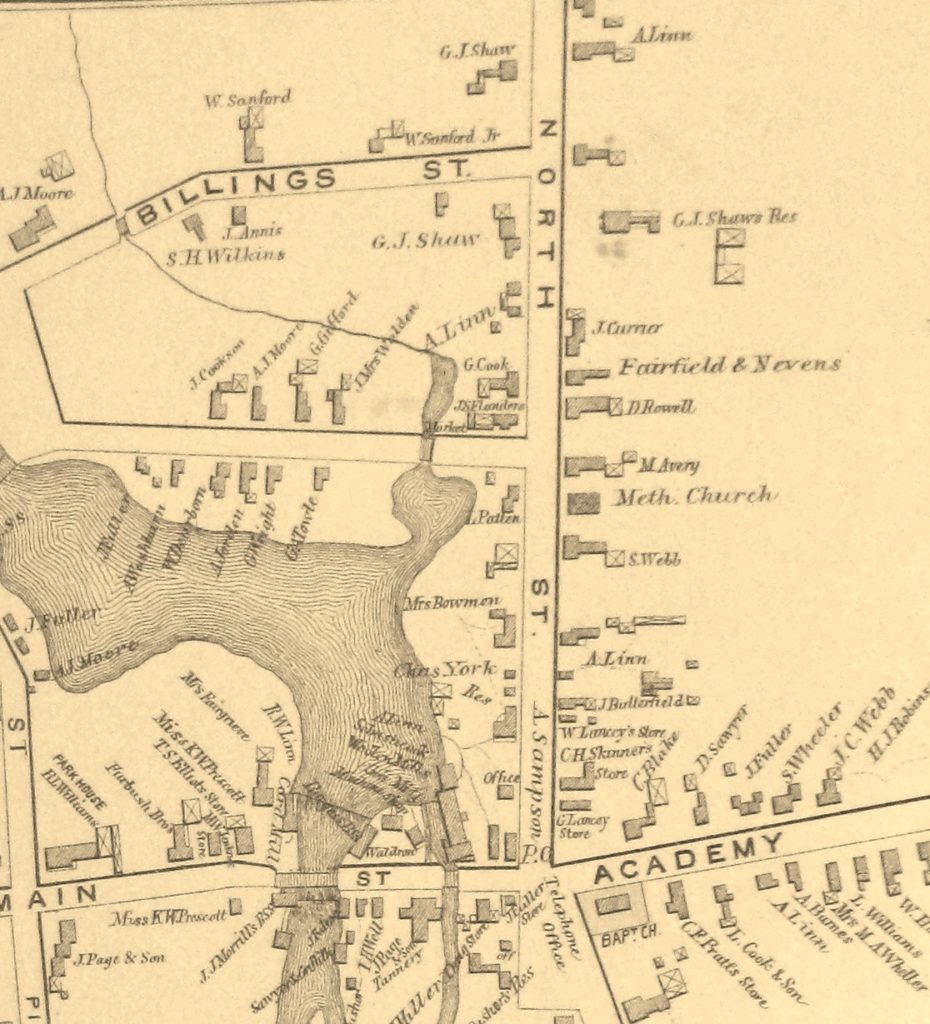
Hartland Village – 1883
(See Maps page for a complete and enlargeable 1883 Map)
*
The Great Flood of 1887 caused major damage to numerous Hartland industries located at the Upper Dam and Lower Dam including the Linn Woolen Mill and the John Page & Son Tannery which ended Page’s tannery operations when he sold out a few weeks later to Archibald Linn. Greenville J. Shaw’s Tannery at the Upper Dam had already been dealing with major shortages of a special tree bark key to the tanning process which had threatened to close his operations and the damaging flood was the final event to cause its demise soon after.
Pittsfield Advertiser – May 1887: “The (raceway) dam between Linn’s Mill and the Grist Mill gave way Sunday morning and the vents through the bridge being choked, the water broke across the (Main) street in front of the Grist Mill and the lower end of the dye house gave way on Tuesday. The (Andrew) Buck Store is very insecure, knocked out some of the area supports. The water went into Morrison’s (Carding) Mill, Knowle’s Shop and White’s Blacksmith Shop. The modus operandi in getting from the west side of the Post Office (then at Alden Sampson’s Drug Store) consists of going up into the Grist Mill, climbing over a lot of flour barrels, through a window upon the roof of a shed and then from the lower side by a plank laid across the rushing water. The section of town known as “Georgetown” (Water Street) is more or less submerged. A house owned by Major (James) Fuller (on the dam end of Water Street) is described at an abrupt angle Sunday, the foundation having gradually been worn away. The Boat House at the Upper Dam and a wing dam connecting to the end of (Greenville) Shaw’s Tannery were carried away. Mr. (Amasa) Moor’s Sawmill (Upper Dam) is all right but on Sunday, some 10,000 logs belonging to him went down river.”
St. Paul (Minnesota) Daily Globe – May 6, 1887: “THE FLOOD IN MAINE: The woolen mills and other factories at Hartland are flooded, and five stores there are undermined and fell from their foundations causing great loss. Boats are used to pass along the streets, and hardly a building has escaped. Archibald Linn, the great mill owner, is the heaviest loser. His damage will be over $150,000, it is thought, and two months will be required to get the factory running.”
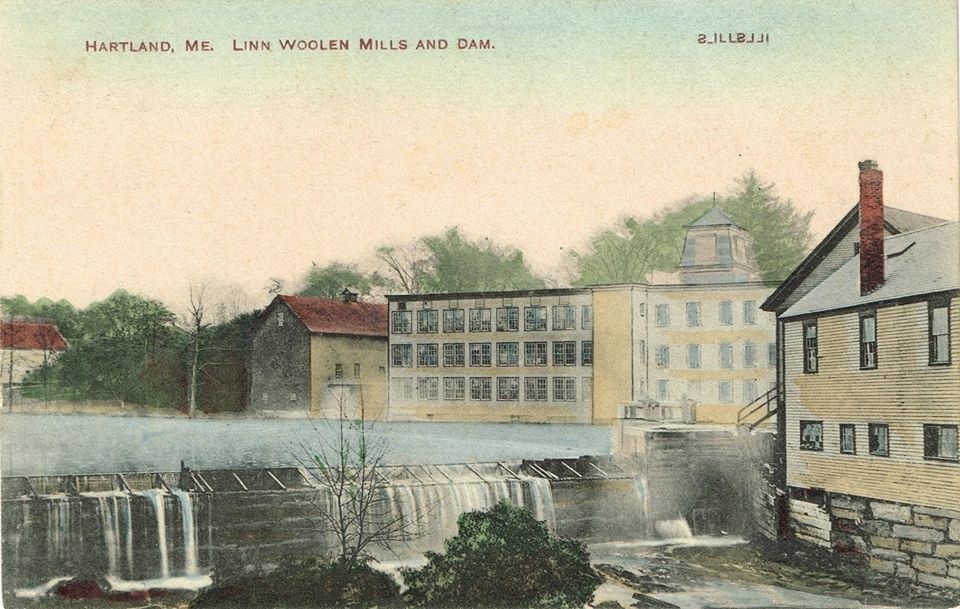
Linn Woolen Mill & Lower Dam
*
As compiled from an 1896 article in the Pittsfield Advertiser, the town of Galashiels, Scotland had an extensive history in the textile industry and furnished five men who had a potent influence in the building of woolen manufacturing mills in Maine including Robert Dobson of Pittsfield (Pioneer Woolen Mill), Archibald Linn of Hartland (Linn Woolen Mill), David Campbell of Sangerville (Dexter Woolen Mill), Lewis Anderson of Skowhegan and Thomas Walker of Warren. All of them became successful woolen manufacturers and took a prominent place in developing the resources of the State and building up their respective localities.
*
Linn Manufacturing Company | 1889-1915
Archibald Linn passed away on November 18, 1889 in Thomasville, Georgia where he gone about 6 weeks previously to seek treatment “on account of his feeble health”. He was predeceased by his wife Grace (Wilson) Linn (1819-1884) and interred with her at Ireland Cemetery joining their children Christiana & William and his mother Anne Nicholas (Golden) Linn.
Following his death, the mill’s operations were taken over by his 3 surviving children, Thomas Archibald Linn, Robert Wilson Linn, Sr and Mary Isabelle (Linn) Fuller along with her husband, Henry Clay Fuller . As noted in Henry’s obituary, he had been hired by Mr. Linn soon after he had married Mary in 1875 when “he was taken into the Linn Office in a confidential capacity, and as he became an expert in wool manufacturing, relieved Mr. Linn of the cares of management for many years.”
*
In his Will, Archibald Linn had recommended Henry oversee the business operations with Linn praising Fuller’s management and business skills. Linn also noted his sons Robert W. Linn, Sr and Thomas A. Linn should play major roles in the company. With Archibald’s blessings, Fuller became President & General Manager of the reorganized Linn Manufacturing Company and along with the Linn brothers, led the way for a new woolen mill building addition in 1890.
Linn’s vast real estate holdings throughout Hartland and the surrounding areas and his numerous business interests initially remained under the watch of his Estate Trustees, Greenville Jefferson Shaw of Hartland and General Charles Hamlin of Bangor, son of former Vice-President Hannibal Hamlin.
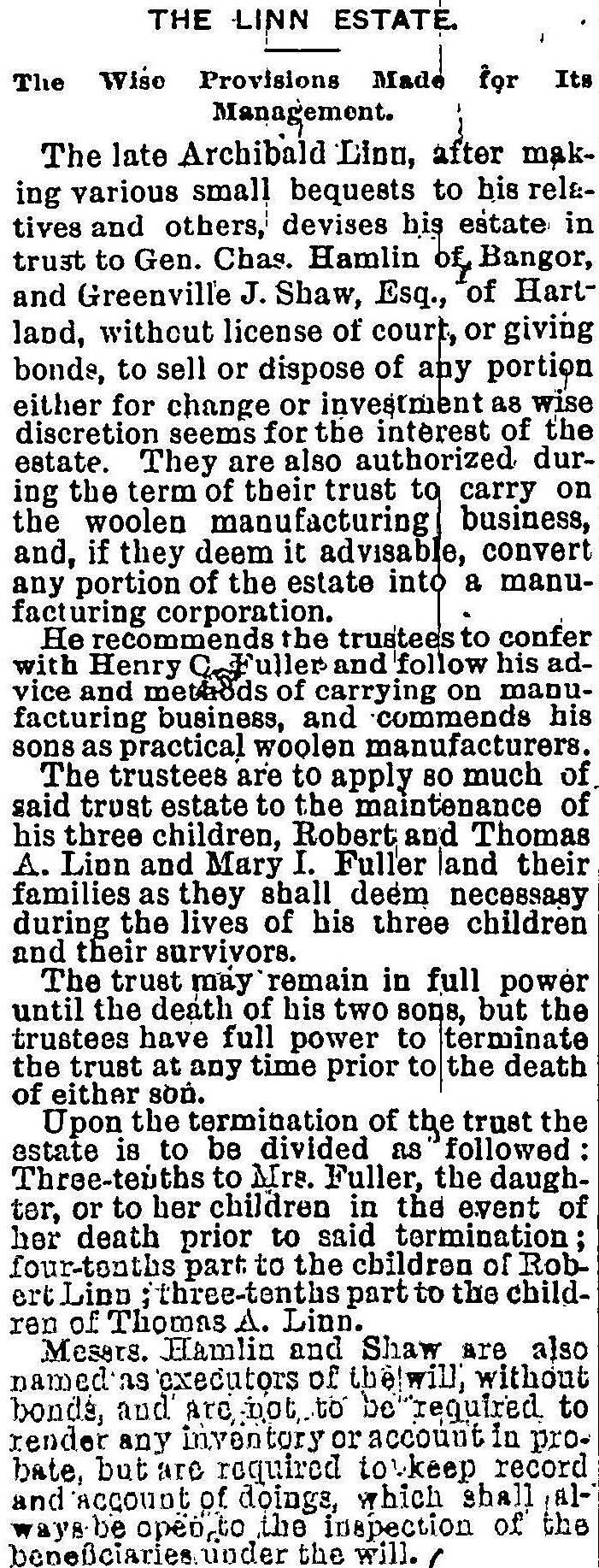
Summary of Archibald Linn’s Will – December 12, 1889
*
Since the 1870s, Archibald Linn had been suggesting in local newspaper article interviews an expansion to his original set of buildings, however a satisfactory location didn’t appear to present itself at the time. That changed a few weeks after the Great Flood of 1887, and the resulting demise of the John Page & Son Tannery on the lower side of the island at the Main Street Dam, when Linn purchased the heavily damaged tannery building and lot for $6,000. Soon after, Linn brought forth a proposal to the town requesting a 10 year tax abatement on a new woolen mill he proposed to build at the former tannery location.
Although Archibald died in November of 1889, a special Town Meeting held in early 1890 granted the proposed tax abatement to the newly formed Linn Manufacturing Company who began demolition and construction soon after. By late September of 1890, the foundation had been completed and within a couple of months, contractor Preston Hersey of Pittsfield had completed initial construction of the new 3 story building measuring 80 feet long x 55 feet wide bordering along Main Street.
The new building was still an empty shell in late 1890 and there was much to do before full scale manufacturing could begin including the addition of a Dye House and a tower to house the large water storage tank for a planned automated sprinkler system.
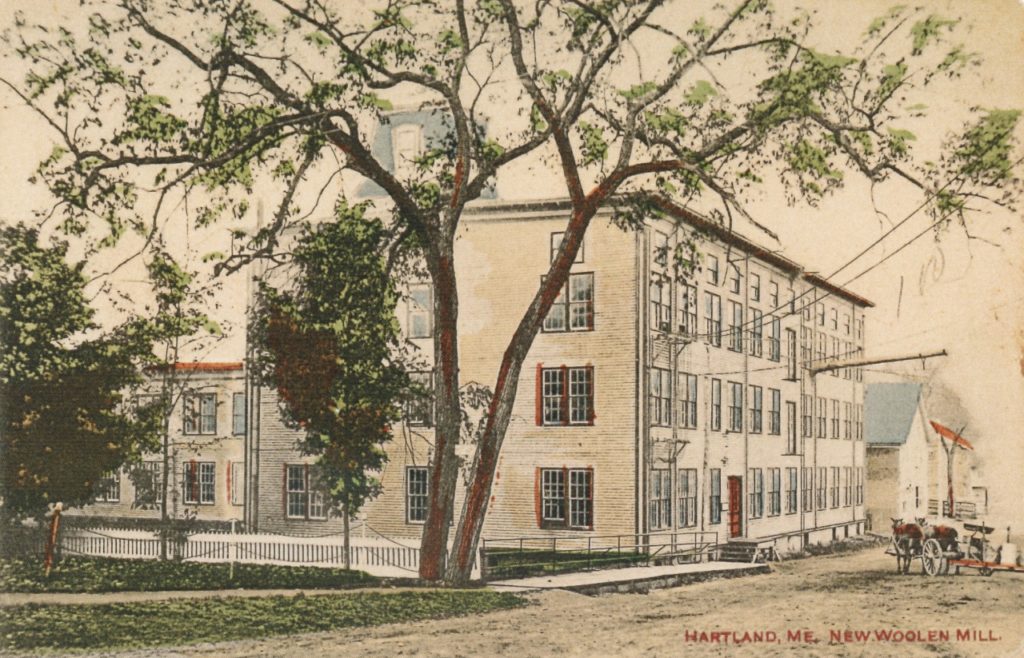
New Linn Woolen Mill with Water Tower and rear 2 story Dye House additions
*
While the new building wasn’t anywhere near ready for manufacturing purposes, it was still cause for a grand celebration by the Linn Manufacturing Company. A local newspaper article noted a large Grand Opening Dedication Ball was held on Friday, January 9, 1891 on the empty 3rd story of the new building to which some 500 people from many area towns attended the lavish event which included a special train run from Pittsfield arranged for the dedication. The 3rd floor was decorated “to present a most brilliant appearance” and featured music by Lougee’s 8 piece orchestra from Bangor for dancing followed by a midnight supper arranged on the 2nd floor. Along with the numerous special guests, each employee of the mill was given a complimentary dance and supper ticket to attend the event.
*
In May of 1892, most of the remaining portion of the former Page Tannery lot behind the new mill building was cleared to make way for the planned addition of a 2 story Dye House to the new building. A local newspaper article lamented the old tannery location having been “removed by the march of progress.”
In the midst of preparing the new building for full operations, the company was awarded a large order in 1894 which likely hindered progress to some point at the new mill. “The Linn Woolen Mill in Hartland has received a $25,000 order for shawls from the U. S. Government for the use of Indians on the Reservations in the West.” ~ Pittsfield Advertiser – June 28, 1894
A May 2, 1895 newspaper article indicates progress clearing the entire lot for the new Dye Room addition noted above had been halted as the old chimney, seen in the 1877 photo above, had just been reported being removed. The article reads, “The chimney of the old Page Tannery, which has been a landmark for many years, was undermined and tipped over the other day to make room for the new building of the Linn Woolen Company. Work has commenced on the foundation and will be finished as rapidly as possible.”
*
It would take until 1896 before the new building was fully completed as workers put the final touches on the structure including completion of the automated sprinkler system water storage tank. Elevators in the building were noted as already functional and shafting to power machines was being placed as they prepared the building for machinery to begin full-time production within a few months…or so they thought.
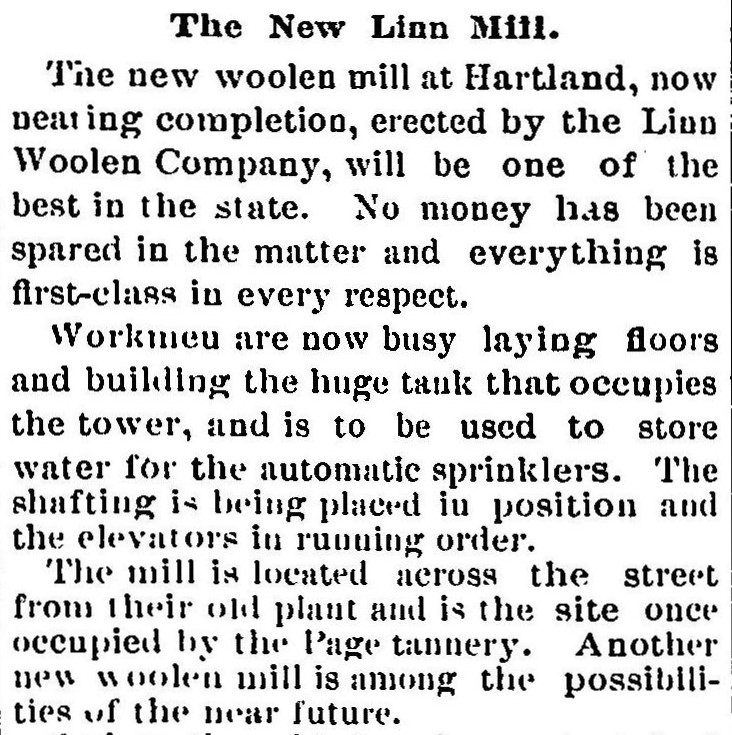
February 13, 1896
*
The new mill building along with its water tower and dye house are seen in this close-up cropped photo below from the 1896 Map. The Linn Manufacturing Company’s woolen mill operations now expanded across most of the entire Lower Dam area on both sides of Main Street with the new mill replacing the former tannery and some of the stores and blacksmith shops which formerly stood on the lower side of the dam.
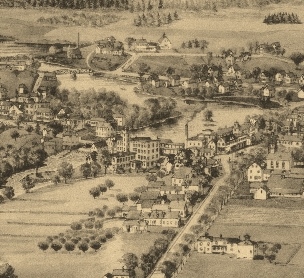
Hartland Village – 1896
(See Maps page for a complete and enlargeable 1896 Map)
*
What the company could not foresee as they made plans in 1896 to purchase and install machinery at the new building was an abrupt change in the woolen market which forced them to delay a large capitol expenditure for new machinery. Some of their existing machines were moved from the old mill into the basement to enable some production with the rest of the building mostly used for storage. Fortunately for the company, a unique opportunity arose a couple of years later to purchase some used carding and spinning machines allowing the company to finally begin full-production throughout their new building soon after.
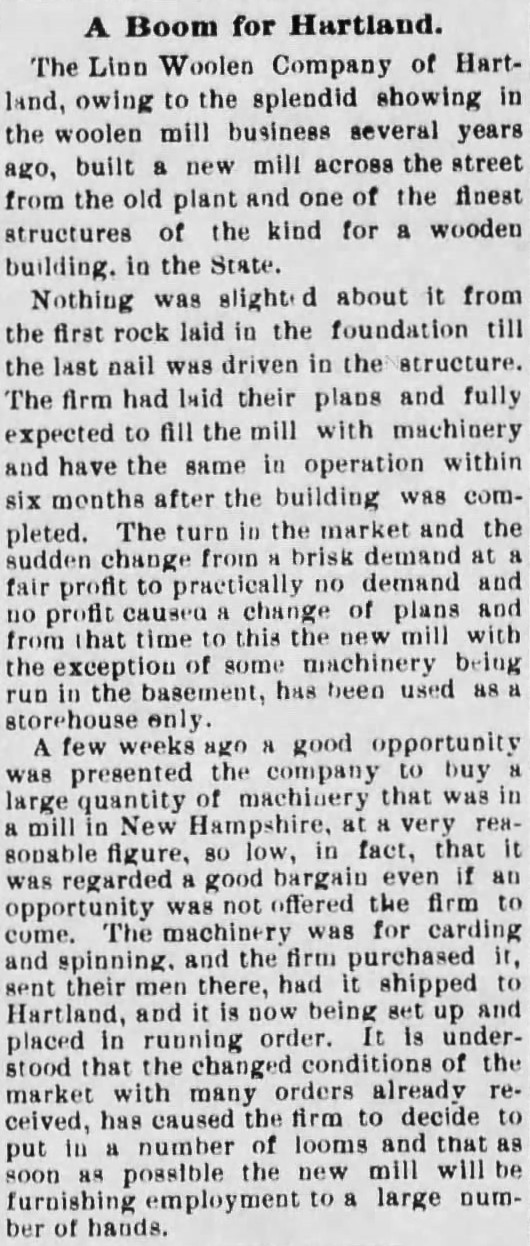
Linn Woolen Mill Machinery Purchase Article – February 9, 1899
*
The 3 Linn Heirs with their spouses and other Linn Family members posed for an undated photo on the roof of the new mill. Some of the names are listed on the back of the photo but they are not identified as to match who is who. Those noted to be in the photo are Thomas Archibald Linn & wife Clarabelle (Osborne), Robert Wilson Linn, Sr & wife Eva (Weymouth) and Mary Isabelle (Linn) & husband Henry Clay Fuller. 2 other unknown couples are only noted as Linn cousins. As noted on the photo, “Bill Linn” is likely to be William Linn, Jr who worked at the mill and was a nephew of Archibald Linn. Both Henry Fuller and William Linn, Jr passed away in 1903.
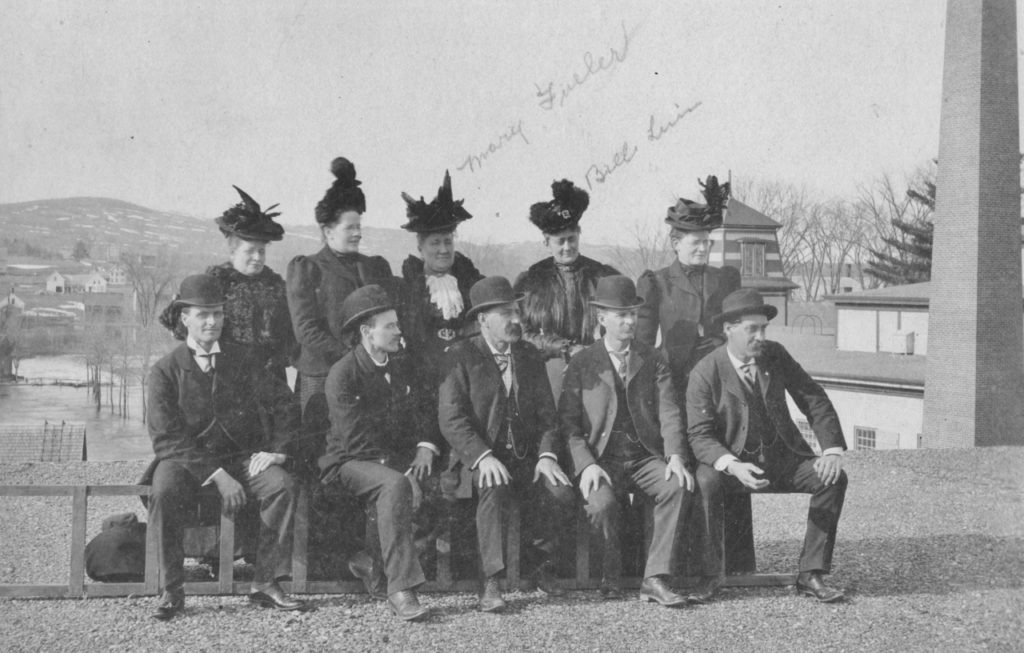
Members of the Linn Family pose on the roof of the new Linn Woolen Mill
*
It is to be noted as part of the history of the Linn Woolen Mill story that the once thriving woolen industry throughout New England was in terrible decline at this time and had induced the creation of the American Woolen Company as noted in an article of their history. “The American Woolen Company was originally established in 1899 through the consolidation of eight financially troubled New England woolen mills. Overproduction, competition and poor management had brought the New England textile industry to its knees by the 1890s. In particular, family trusts, the main shareholders of many of the mills, insisted on receiving high dividends instead of making necessary capital improvements.”
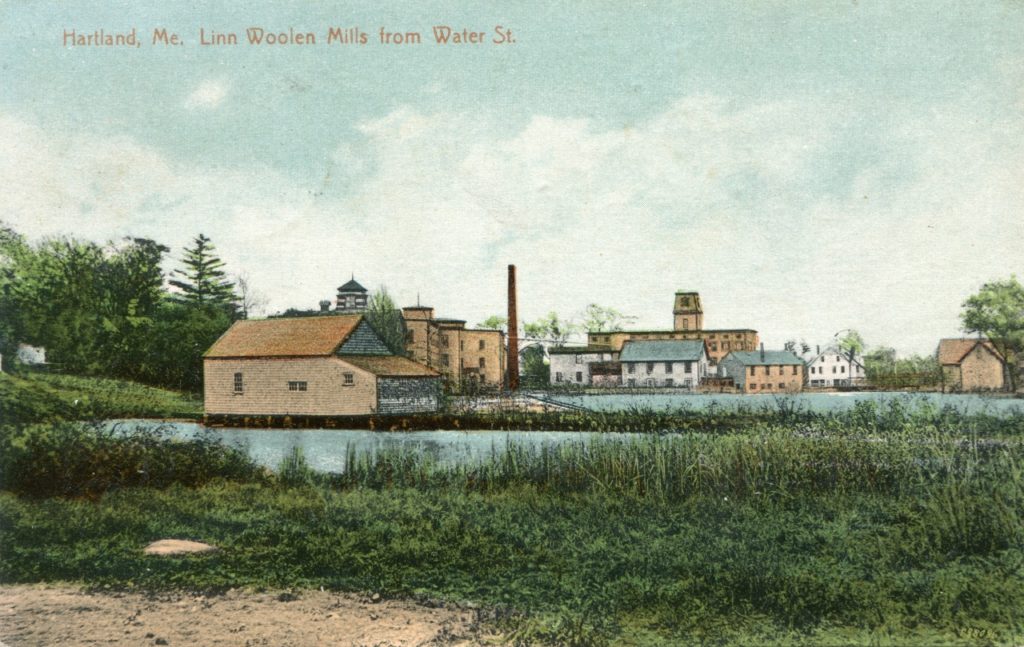
Linn Woolen Mills from Water Street
*
With the addition of the new modern state of the art building which substantially increased their production capabilities, the company was soon able to efficiently compete in a regionally down market and take on more larger and lucrative orders nationally resulting in the addition of an evening shift added to their regular work week.
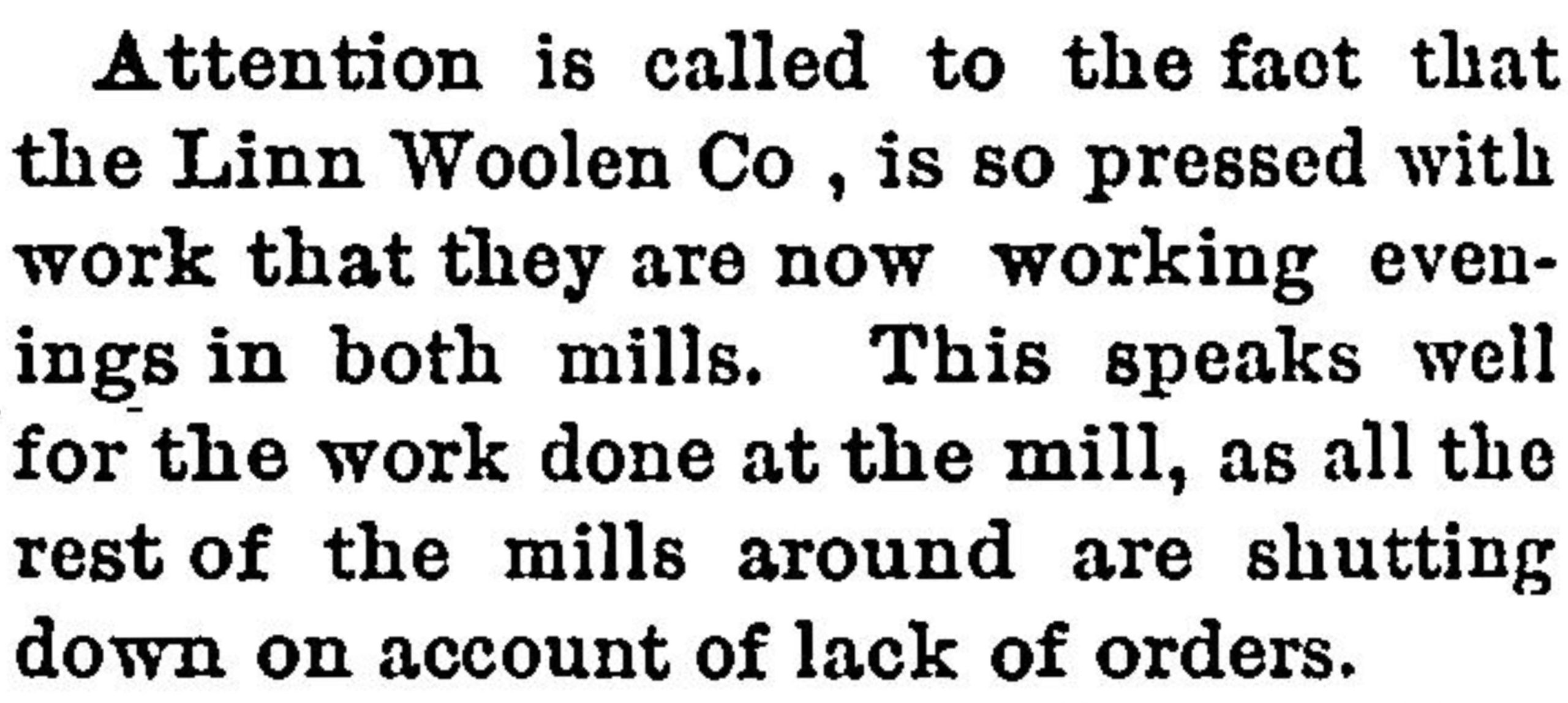
Pittsfield Advertiser Article – August 16, 1900
*
In the Fall of 1900, the Linn Manufacturing Company began construction on an additional building located behind their newly built woolen mill. As noted in an October 27, 1900 newspaper article on its progress, the new 3 story building was 100 feet long x 60 feet wide and was being constructed by Harrison T. Burns of Fairfield. The article noted hard pine timbers were being used in the event heavy machinery might be later moved into the building.
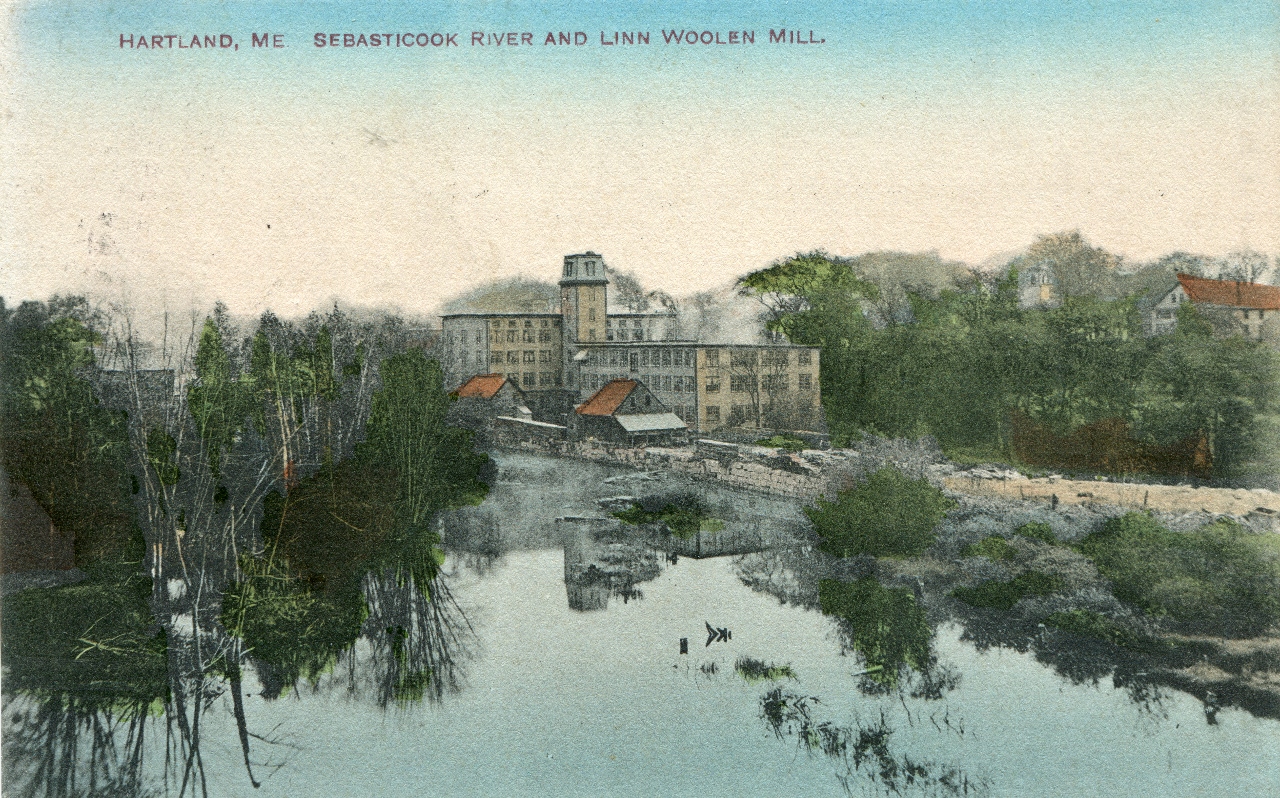
New 3 story rear addition to the Linn Woolen Mill seen from Pittsfield Avenue
*
Fuller-Osborne Company
In 1901, Henry C. Fuller and his son-in-law George Teel Osborne expanded operations of the Linn Manufacturing Company with a new associated business called the Fuller-Osborne Company. The new company had several business interests including real estate, newspaper printing and a greenhouse operation on Elm Street but their largest business operation was in clothing production. Henry’s brother-in-law Thomas A. Linn would also take part ownership in the company by 1902.
Among the Fuller-Osborne Company’s numerous business ventures, the largest and most successful was the Fuller-Osborne Manufacturing Company which produced skirts and various other clothing items. Production operations were moved into the new 3 story building built behind the new woolen mill in 1900 as noted in a Pittsfield Advertiser article from December 12, 1901: “The entire third floor of the new mill contains the plant of the Fuller-Osborne Manufacturing Company, which is doing an extensive business in manufacturing of ready-made clothing, ladies’ capes, skirts and other lines of goods of this character.”
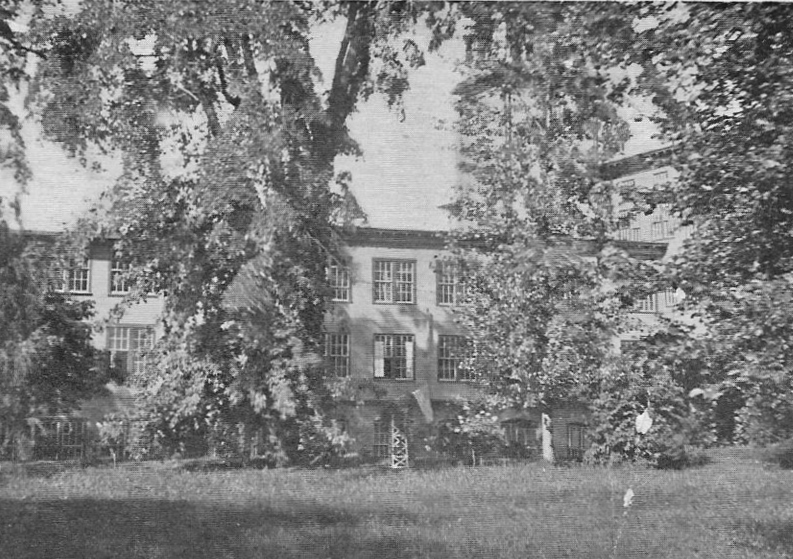
Photo noted as “Home of Sebasticook Skirts” taken from behind A. W. Miller’s Main Street Drug Store
(Courtesy of Maggie Smith)
*
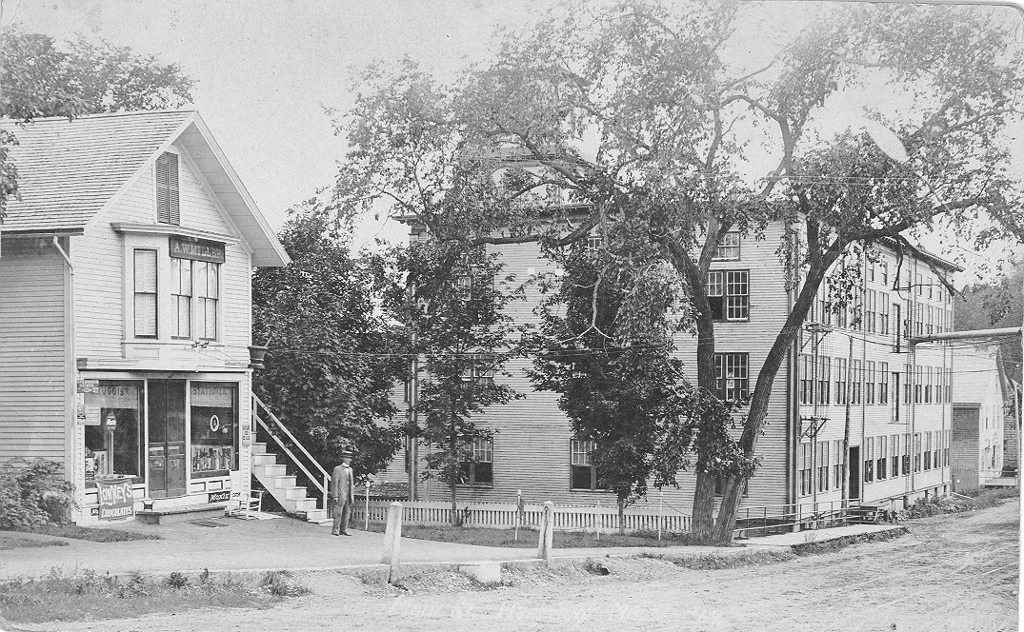
A. W. Miller Drug Store & New Linn Woolen Mill – c1903
*
“The Scotch Thistle Greenhouses, which have been built by the Fuller-Osborne Company in this village this season are now completed and the growing of flowers of all kinds is progressing finely. The owners of this new enterprise announce that they are now ready to supply anything in this line at short notice. The houses are under the charge of a florist who has had much experience in this work and he knows how to produce the daintiest and sweetest flowers imaginable.” ~ Pittsfield Advertiser – 1901
*
On March 11, 1903, Henry Clay Fuller succumbed to his long battle with Tuberculosis at just 49 years old at Boston City Hospital where he had gone to seek advanced treatment. His wife Mary (Linn) Fuller had the Fuller Mansion built across from their original homestead on Elm Street in 1904 next to the Scotch Thistle Greenhouse following his death.

Fuller Mansion & Scotch Thistle Greenhouse on right – Elm Street – c1910
*
As noted in his 1903 obituary, Henry C. Fuller also personally invested in other local area business interests. “Several years ago Mr. Fuller, with George Dobson and J. W. Manson of Pittsfield, bought the woolen mill in Newport, which has been successfully operated by them since that time. Of this corporation, Mr. Fuller was the Treasurer and Wool Buyer.”
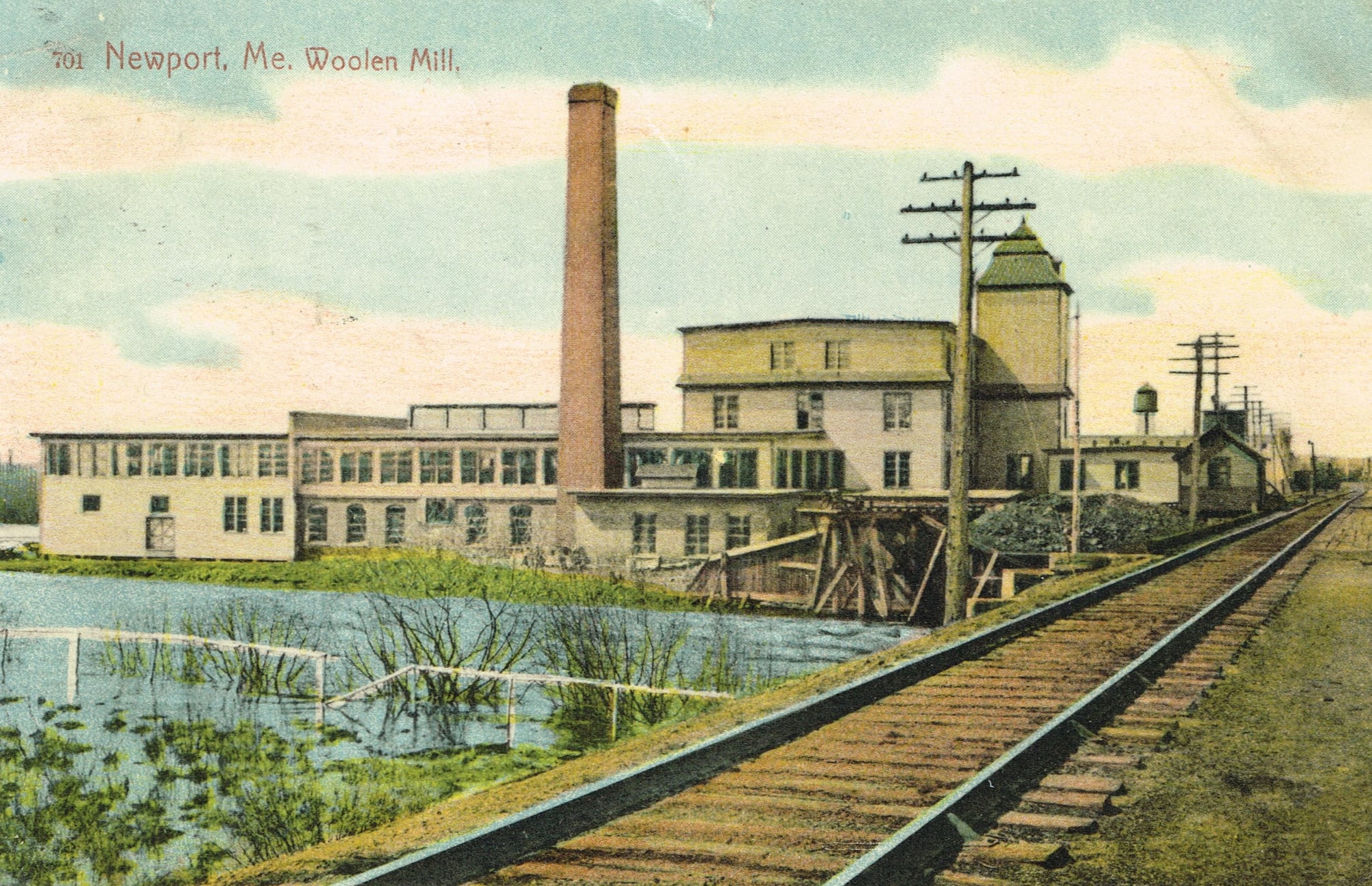
Newport Woolen Mill – c1905
*
Although Henry Fuller’s death was a devastating loss to the company, Thomas Archibald Linn, who had been Treasurer of the Linn Manufacturing Company since 1889, was able to step into the role as its President following Henry’s death and continued operating the businesses with great success while living with his family on Blake Street.
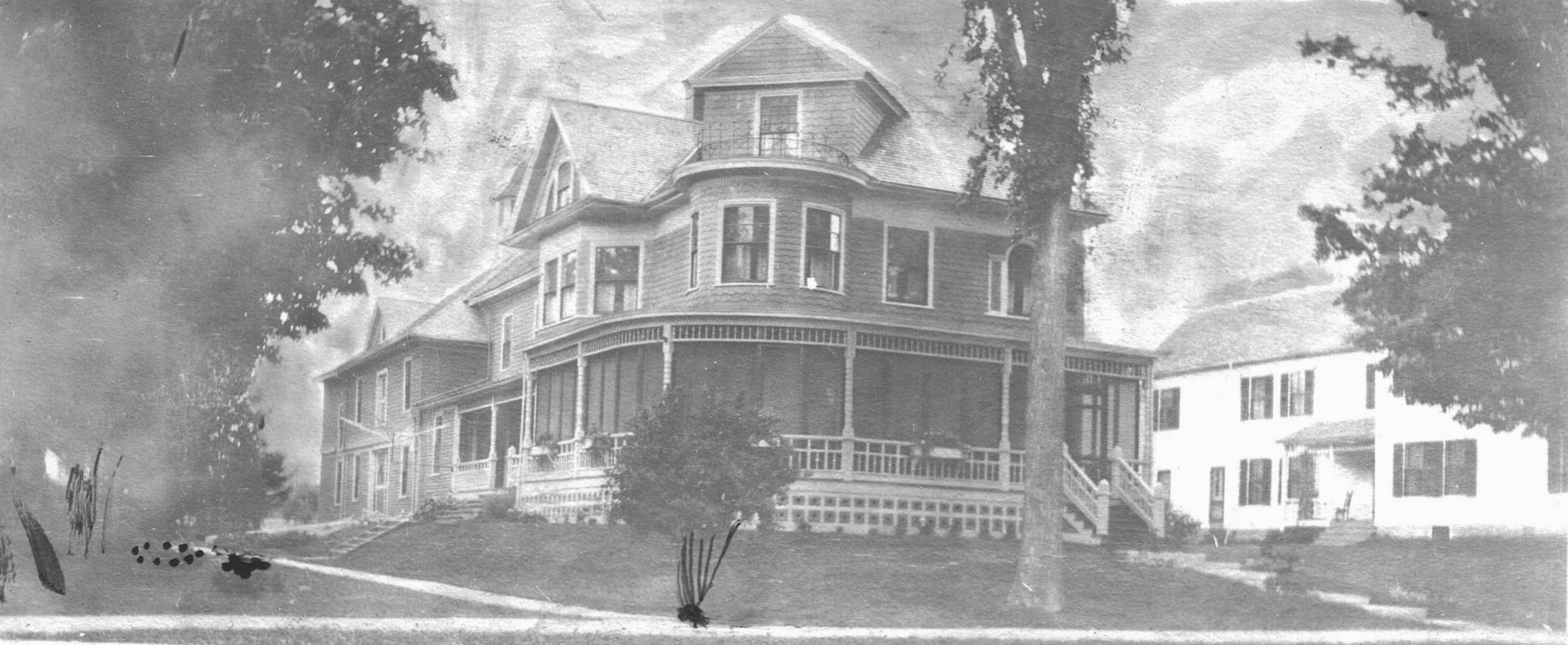
Thomas & Clarabelle (Osborne) Linn Residence at Academy & Blake Street
*
A 1902 article notes, “Thomas was educated in the public schools of Lawrence, Massachusetts, where the family moved when he was a young child, and also attended an Episcopalian school at Portland, Maine. He went into the mills to work at Lawrence when very young, and learned the business of textile manufacturing from bottom to top. He engaged in manufacturing on his own account, and at the present time is Treasurer of the Linn Manufacturing Company, of Hartland, Maine, and is an owner in the Fuller-Osborne Manufacturing Company of the same town. He has taken a leading position among the manufacturers of his section and has done much to make the town of Hartland a busy industrial center.”
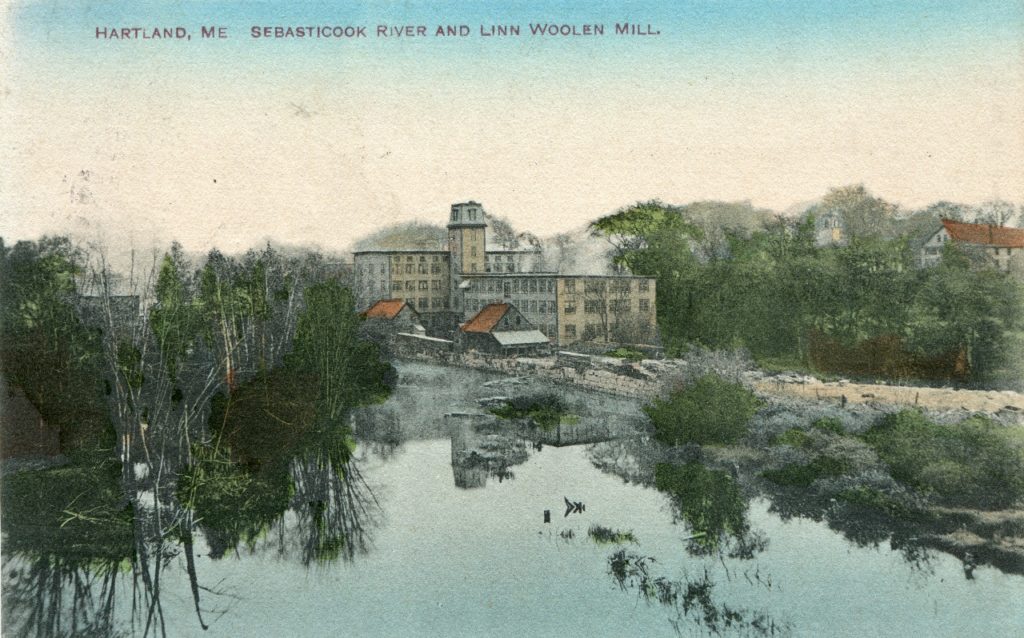
Linn Woolen Mill from Pittsfield Avenue
*
On November 13, 1903, Greenville Jefferson Shaw also passed away in Bath. Shaw had been a friend and business associate of Archibald Linn for many years and had been named by Linn to be one of the Executors of his Estate in his Will. Shaw’s great success in the tanning business in Hartland and his numerous other endeavors, among others breeding champion race horses at his Commercial Street residence, had made him an invaluable overseer for the young Linn heirs and most certainly a wise and experienced voice of reason in some of their early business decisions.
*
Officers of the Fuller-Osborne Company in 1907
President – Robert Wilson Linn, Sr | Secretary – Thomas Archibald Linn | Treasurer – George Teel Osborne | Superintendent – Daniel A. Packard
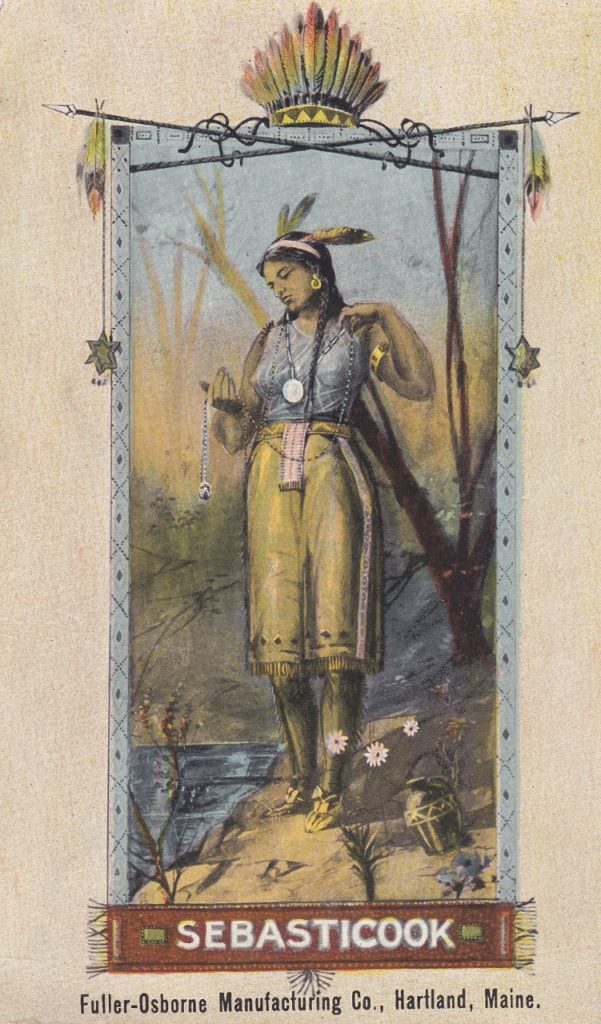
Fuller-Osborne Manufacturing Company Post Card
*
As their clothing manufacturing business grew, demand for labor increased significantly over the years.
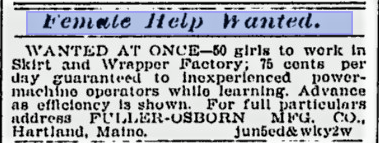
Fuller-Osborne Manufacturing Help Wanted Ad – 1905
*
The company’s trademark “Sebasticook Walking Skirt” became a very popular fashion item nationally and was in such high demand in 1907 they were unable to fill orders by the end of the year. They eventually expanded some of their production in Pittsfield.
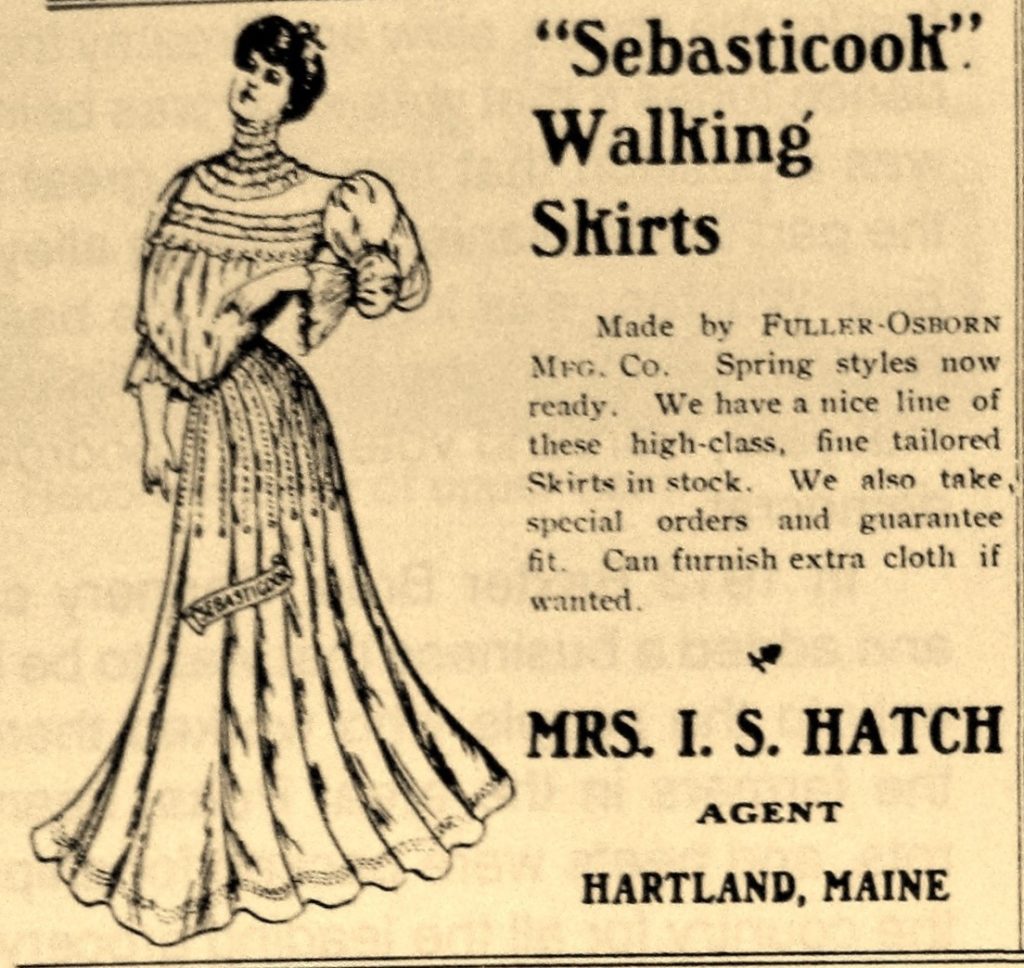
Sebasticook Walking Skirt featured in a 1907 Advertisement
*
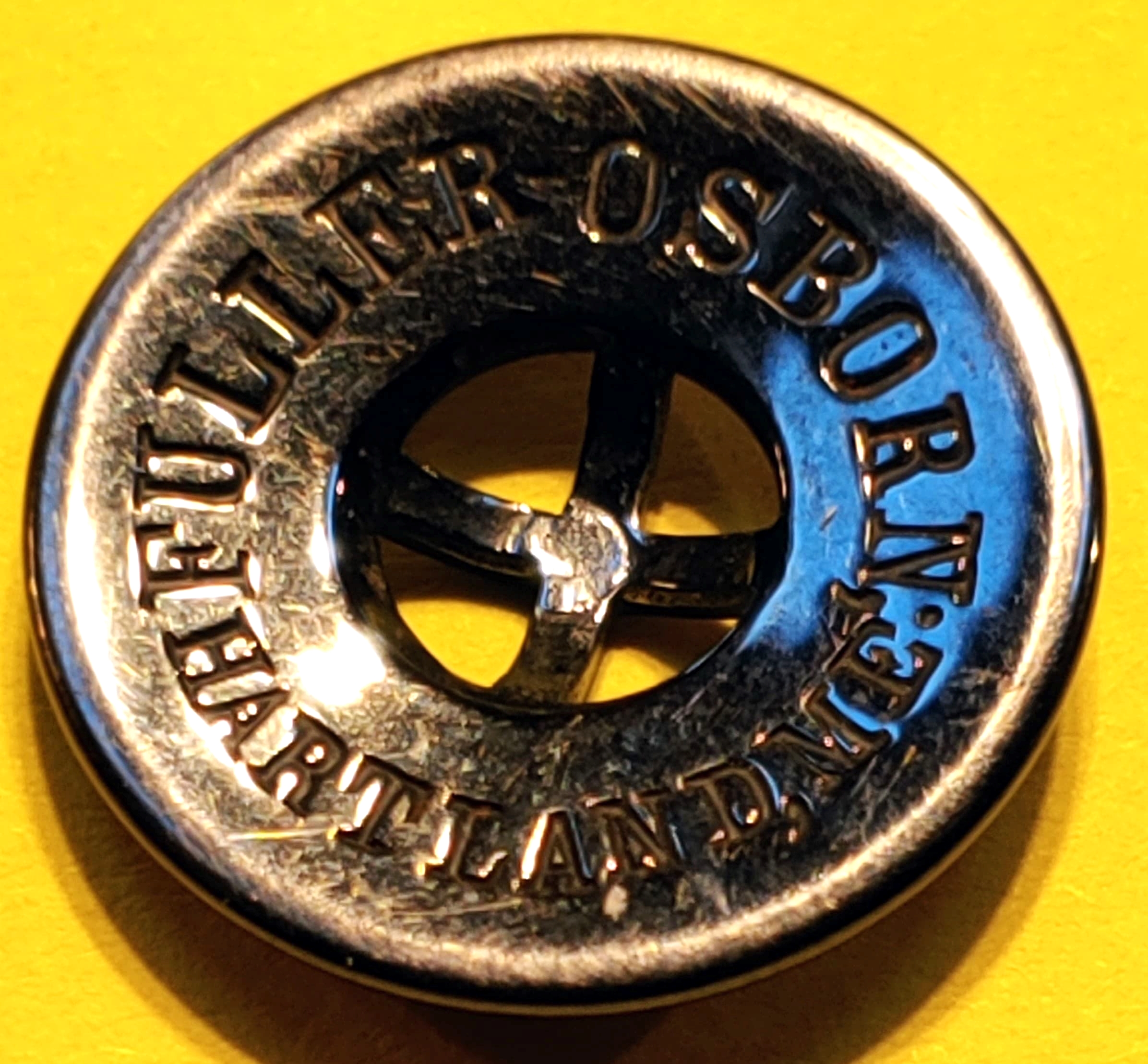
Fuller-Osborne Manufacturing Button
(Photo courtesy of Sam Fuller)
*
In 2020, a group of followers from the Hartland Historical Society’s Facebook Group rallied together to purchase an original Sebasticook Walking Skirt manufactured by the Fuller-Osborne Manufacturing Company being offered for sale online then graciously donated it to the Hartland Historical Society for our collection.

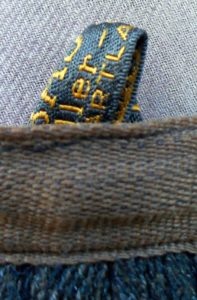
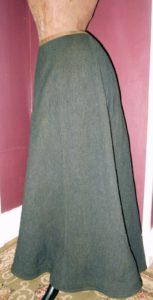
Sebasticook Walking Skirt as seen on the online advertisement
*
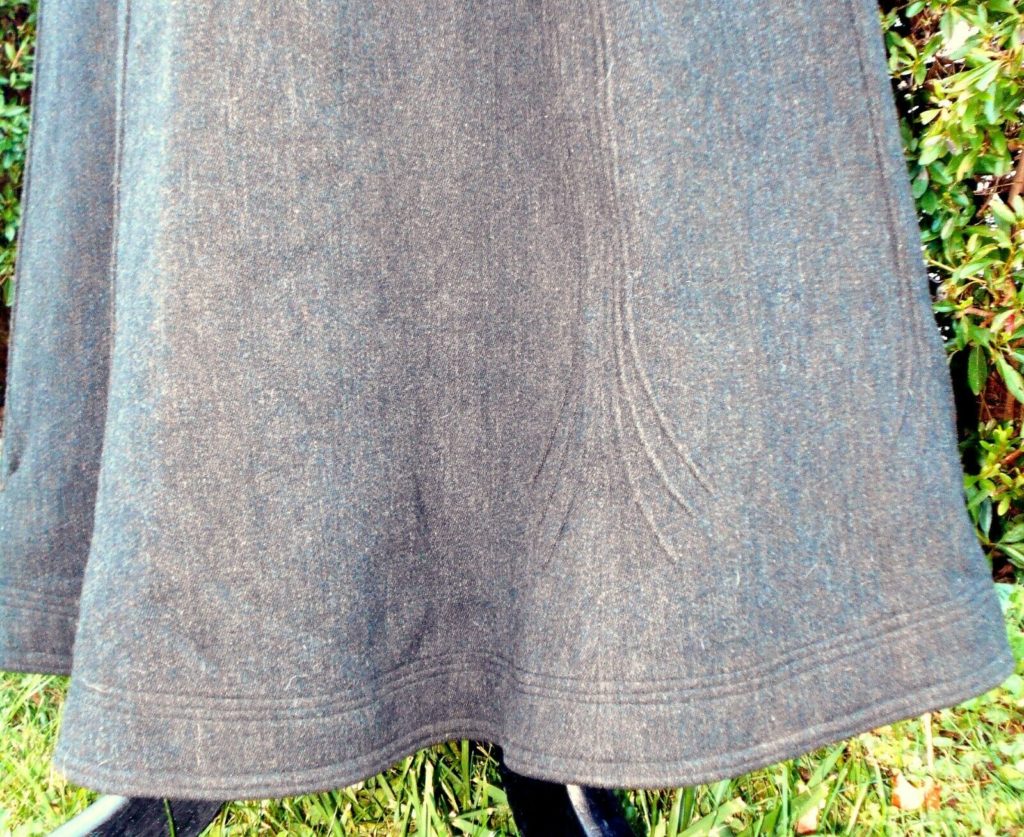
Close Up of the Sebasticook Walking Skirt Details
*
Officers of Fuller-Osborne Company standing on the roof of the new Linn Woolen Mill – 1910
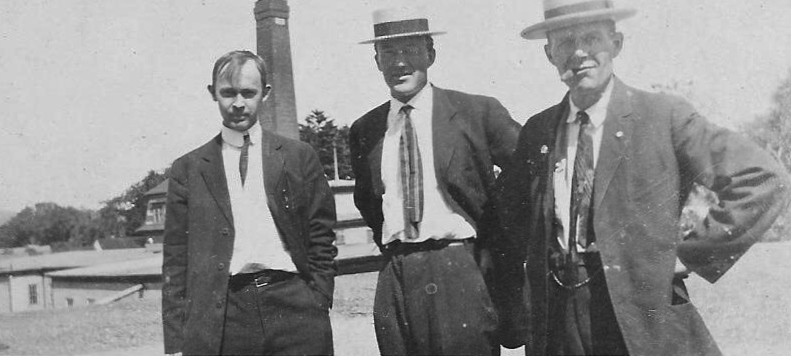
(L-R): Fred Fuller | Percy Butterfield | Jim Young
(Courtesy of Maggie Smith)
*
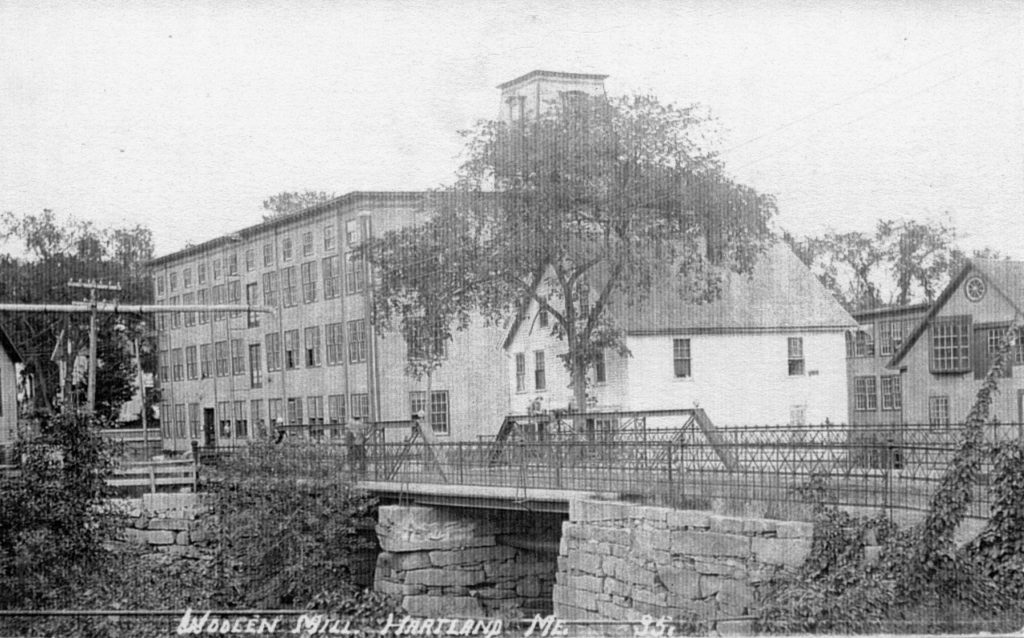
New Linn Woolen Mill – c1915
*
Along with its many other business endeavors, the Linn Manufacturing Company also took great interest in the Upper Dam. In 1900, they acquired the rights to the dam and the former Moor Family woodworking buildings located near the dam on Moore Street from Walter H. Moore. Water was a vital resource for providing steam power at the woolen mill operations further downstream and controlling its flow appeared to be a major priority for the company when it rebuilt the Upper Dam in the early 1900s.
One of the former Moor Woodworking buildings, which had been operated by Walter’s Uncle James W. Moor as a furniture, casket & coffin manufacturing business, was purchased by Frank Griffith around 1904 and moved to Mill Street near the bridge where Frank opened his woodworking shop. Walter and several business partners continued operations for several more years at the remaining woodworking building before it was taken over by Fred S. Burrill around 1913 before being sold in the Great Auction of 1932.

Upper Dam Rebuild
*
Upper Dam Purchase Article – Pittsfield Advertiser – July 4, 1901
“A year or more ago the Linn Woolen Company purchased from Walter Moor the water power at the Moor Mill, paying a large sum, and now has one of the best powers in the state for its business. Between the Upper Dam and the dam at the Linn Woolen Company’s mill there is quite a mill pool and by regulating the gates at the Upper Dam the head of water on the Linn Company’s wheels is maintained at a given point at all times and there is sufficient amount so that the company will never in all probability be called upon to use steam for power, notwithstanding an immense power is required to run the machinery in both their mills.
The company is now having a new boiler set which will increase the amount of steam available by 100 horse power to be used in dyeing and as needed for other purposes. The company’s business at present is as good probably as most any mill in the state, but the proprietors do not regard the outlook as especially bright. The conditions of the woolen business are not of a very settled character and as a well-known woolen manufacturer remarked Friday, the reputation of a firm does not count now in the sale of goods. It’s the fabric that talks and the mill that banks upon a reputation acquired in the past is wasting valuable time. It’s the mill that meets the demand that gets the orders.”
*
In 1898, the Linn Manufacturing Company purchased land from Greenville J. Shaw at the Upper Dam where the former Shaw Tannery had been located along with Shaw’s property across the street. The exact date is unknown but soon after, they built 4 identical houses on the property across from the former tannery on Upper Mill Street for use by some of their management employees and their families. At some unknown date before the Great Auction of 1932, these 4 houses were privately sold and did not appear on the auction listing.
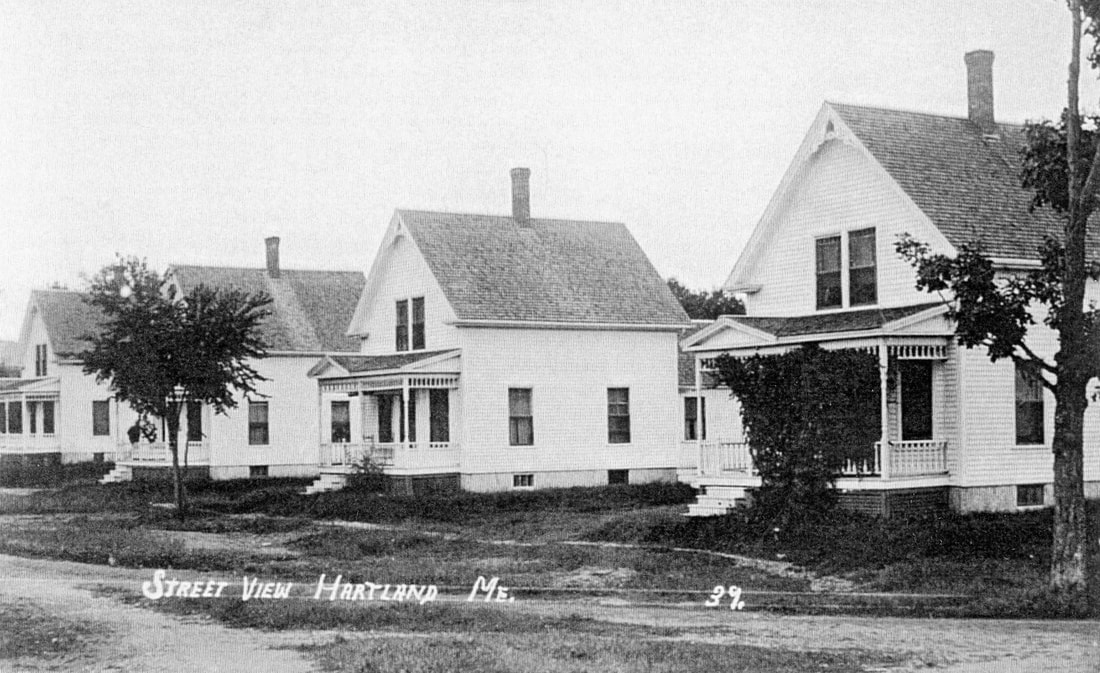
Former Linn Woolen Mill houses on Upper Mill Street
*
In 1898, the Linn Manufacturing Company also purchased the Fairgrieves Homestead and property followed by their purchase of the remaining property past the homestead from Caroline Prescott in 1902 effectively splitting the future Hubbard Avenue lot into 2 sides with the other side owned by Ensign Hubbard.
Soon after, they extended the Main Street entryway past the former Fairgrieves Homestead and built 3 nearly identical houses on their property as homes for some of their management employees and their families. The 1910 Census lists 5 families residing on what is noted as Linn Street with all the Head of Households and several family members working at the woolen mill. The 3rd house had a separate garage where its driveway on the outside of the bend eventually connected the new street to Hubbard Avenue by 1917.
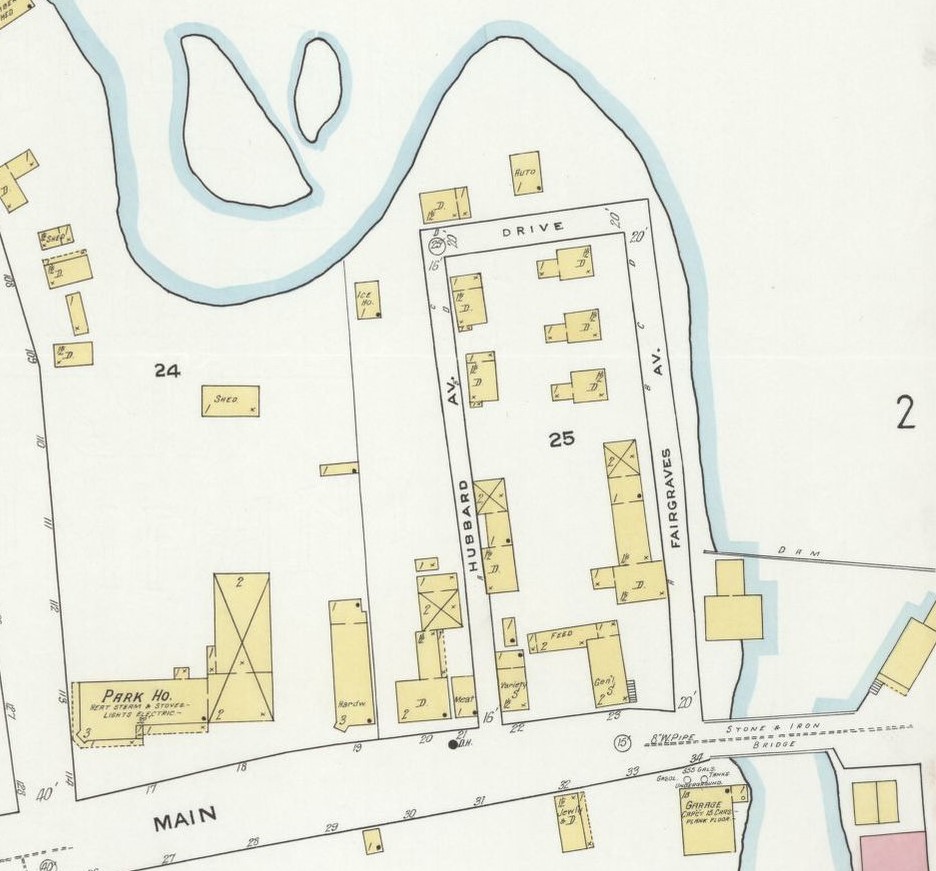
Sanborn Insurance Map – 1917
*
Between the release of the 1917 Sanborn Map above and the Great Flood of 1923, the American Woolen Company razed the entire former Stinchfield-Fairgrieves Homestead and built a 4th new house on the lot leaving the property where the attached buildings had stood as an open lot. All 4 houses and the open lot would be sold during the Great Auction of 1932 as part of the American Woolen Company’s real estate holding it had purchased from the Linn Manufacturing Company in 1916.
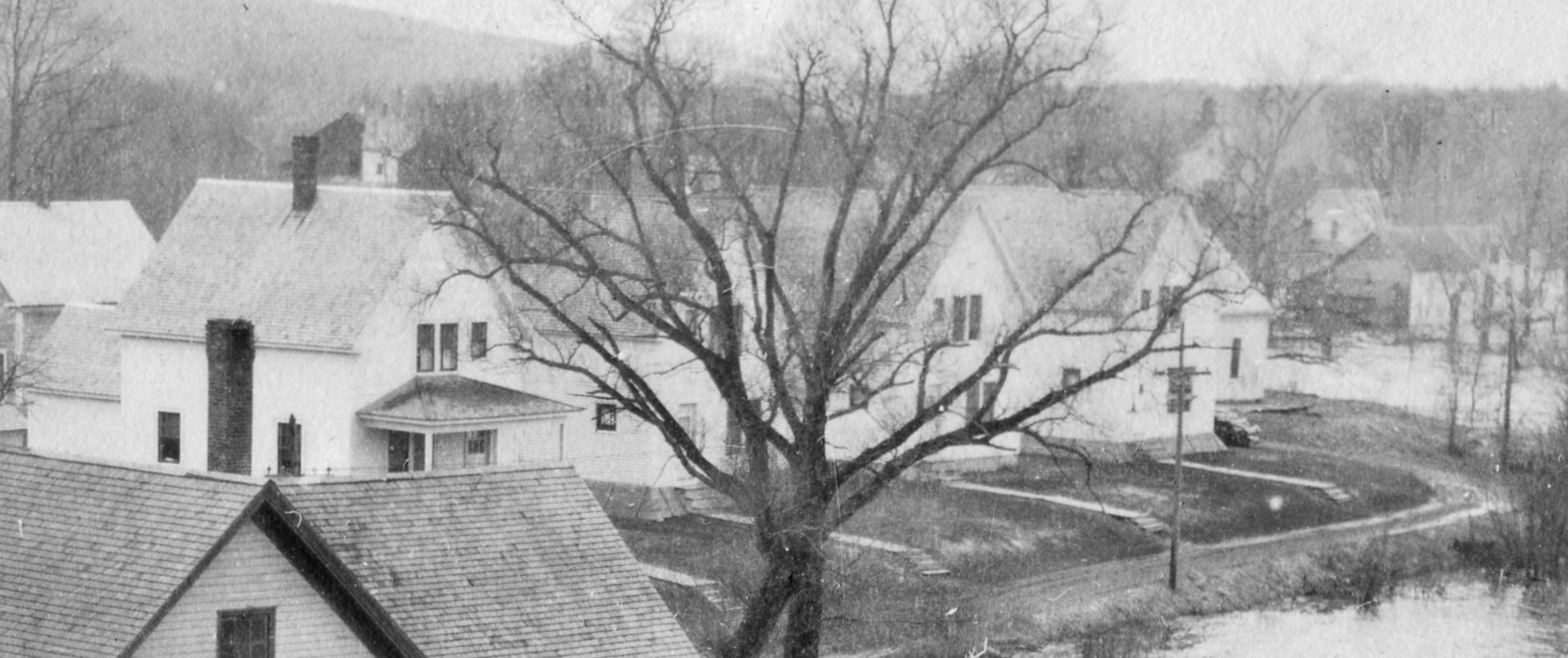
Former Woolen Mill houses on Hubbard Avenue – 1923
*
Another fatal accident at the Linn Woolen Mill as reported by the Pittsfield Advertiser on March 23, 1905:
“Ronald Bean, 24 years old, was fatally scalded in the dye room of the Linn Woolen Mill in Hartland on Friday. Mr. Bean was stirring wool in the dye vat and standing between that vat and one of boiling hot water. In reaching with a fork into the dye vat, he lost his balance and fell backward into the scalding water. He was hastily rescued from the vat, but was so badly scalded that Dr. Jennie Fuller, who was first summoned and who dressed the burns, gave almost no hopes of his recovery and his death resulted Sunday evening. The deceased was the son of Mr. and Mrs. Dana Bean of Harmony who were both hastily summoned after the accident and remained with their son until his death. This is one of the saddest and most terrible accidents to occur in Hartland for many years.”
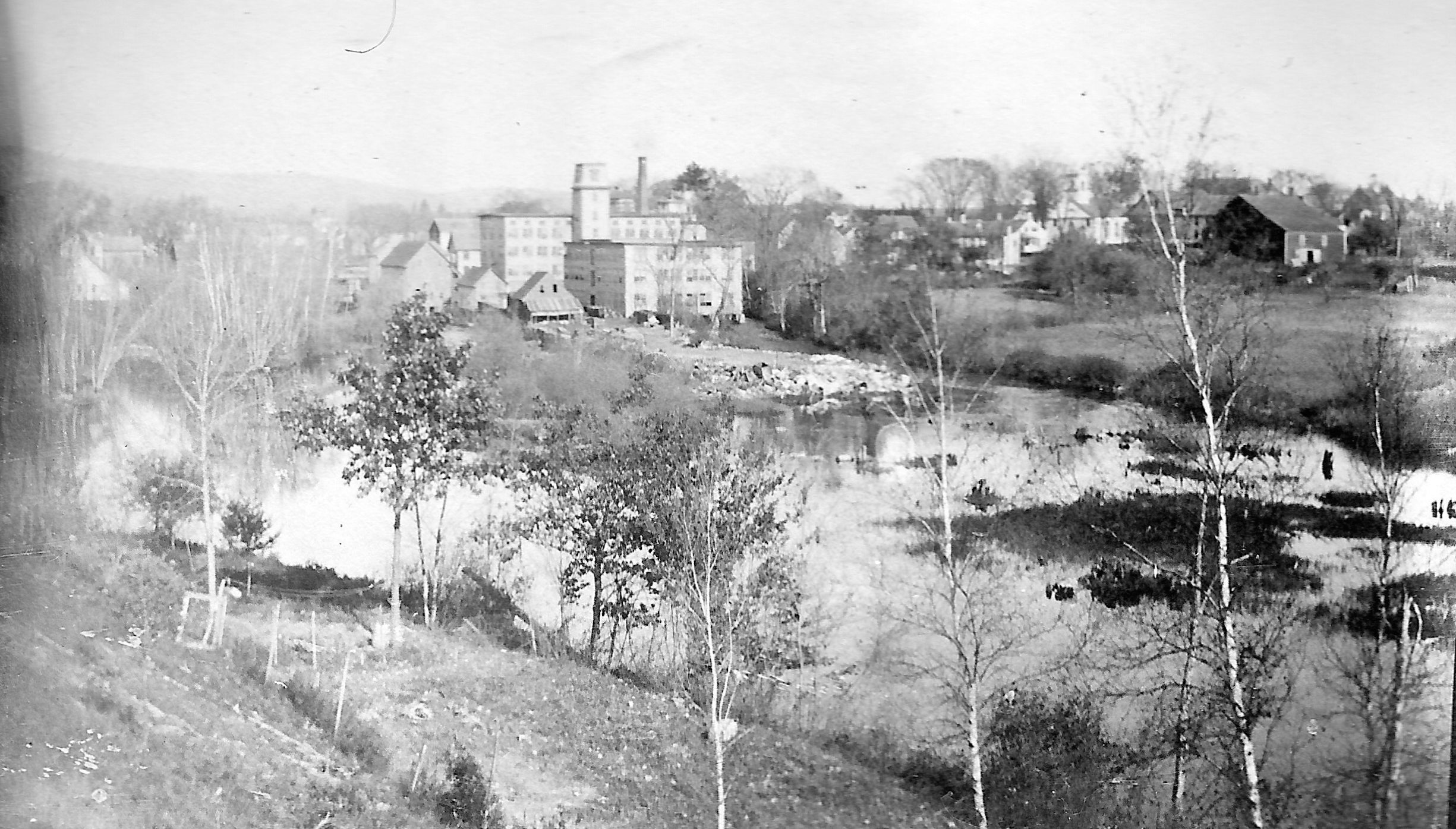
Linn Woolen Mill from Pittsfield Avenue
*
For several decades, much of Hartland’s public water supply was controlled by the Linn Woolen Mill including several fire hydrants the company maintained and leased to the town. With advances in modern plumbing becoming more available and affordable to individual residences after the turn of the century, Hartland eventually developed its own independent means of supplying water with the creation of the Hartland Water Company in 1911 which constructed a 6 mile water main pipeline from Starbird Pond the following year.
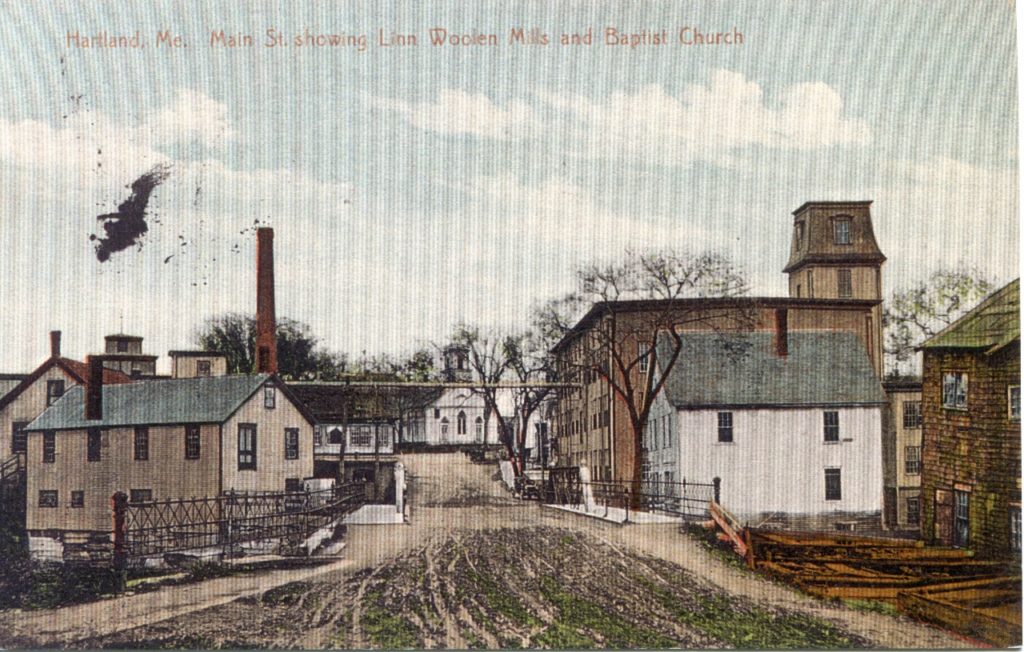
Main Street – c1912
*
A little over 11 years after taking over the leadership of the Linn Manufacturing Company and the Fuller-Osborne Company, Thomas A. Linn passed away on April 21, 1914 at 59 years old. Thomas had successfully continued the companies operations and growth following the death of his predecessor and brother-in-law Henry C. Fuller in 1903.
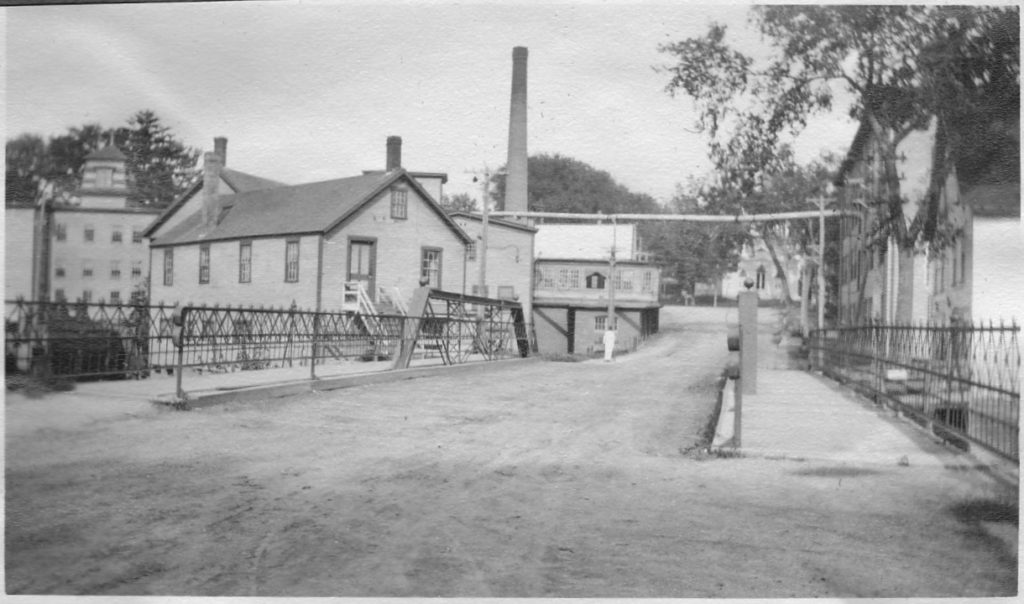
Main Street – c1912
*
There were undoubtedly numerous circumstances which contributed to the demise of the Linn Manufacturing Company but one significant factor which directly coincided with the company’s eventual end came with the death of Thomas A. Linn in 1914. The company seemed unable to successfully function from this point on and finally bowed to financial pressures declaring bankruptcy the following year in 1915.
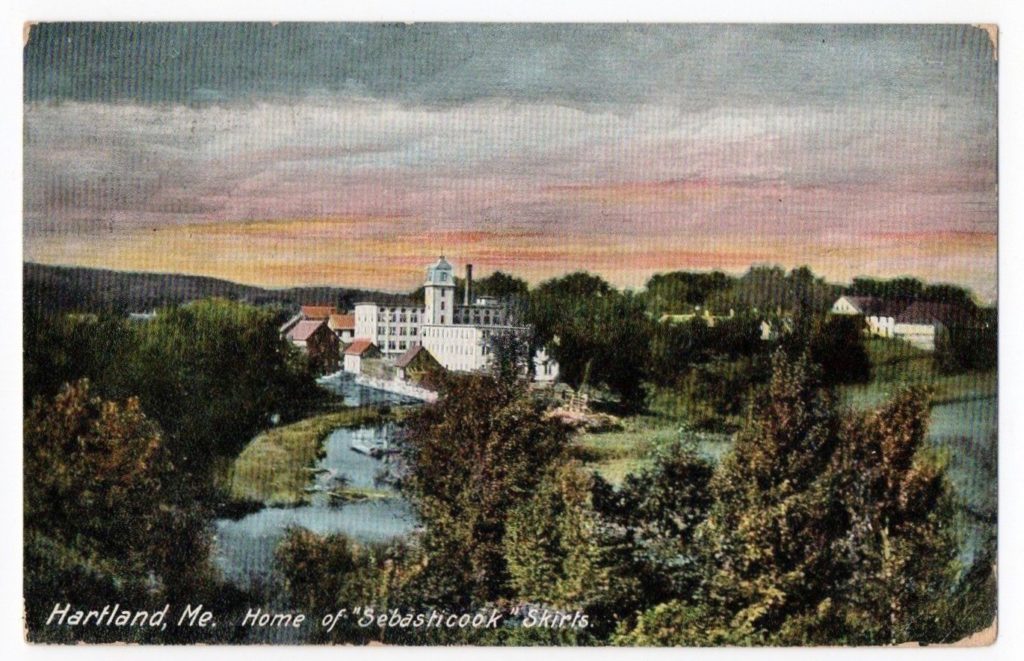
Linn Woolen Mill from Pittsfield Avenue
*
Just before the Linn Manufacturing Company declared bankruptcy, the Fuller-Osborne Company reorganized and incorporated as a separate company in late 1914 as noted in an article of newly formed corporations in New England.

Boston Globe – Published January 4, 1915
*
In order to raise more funding for the new company, capital stock shares were publicly offered at $12.50 each.
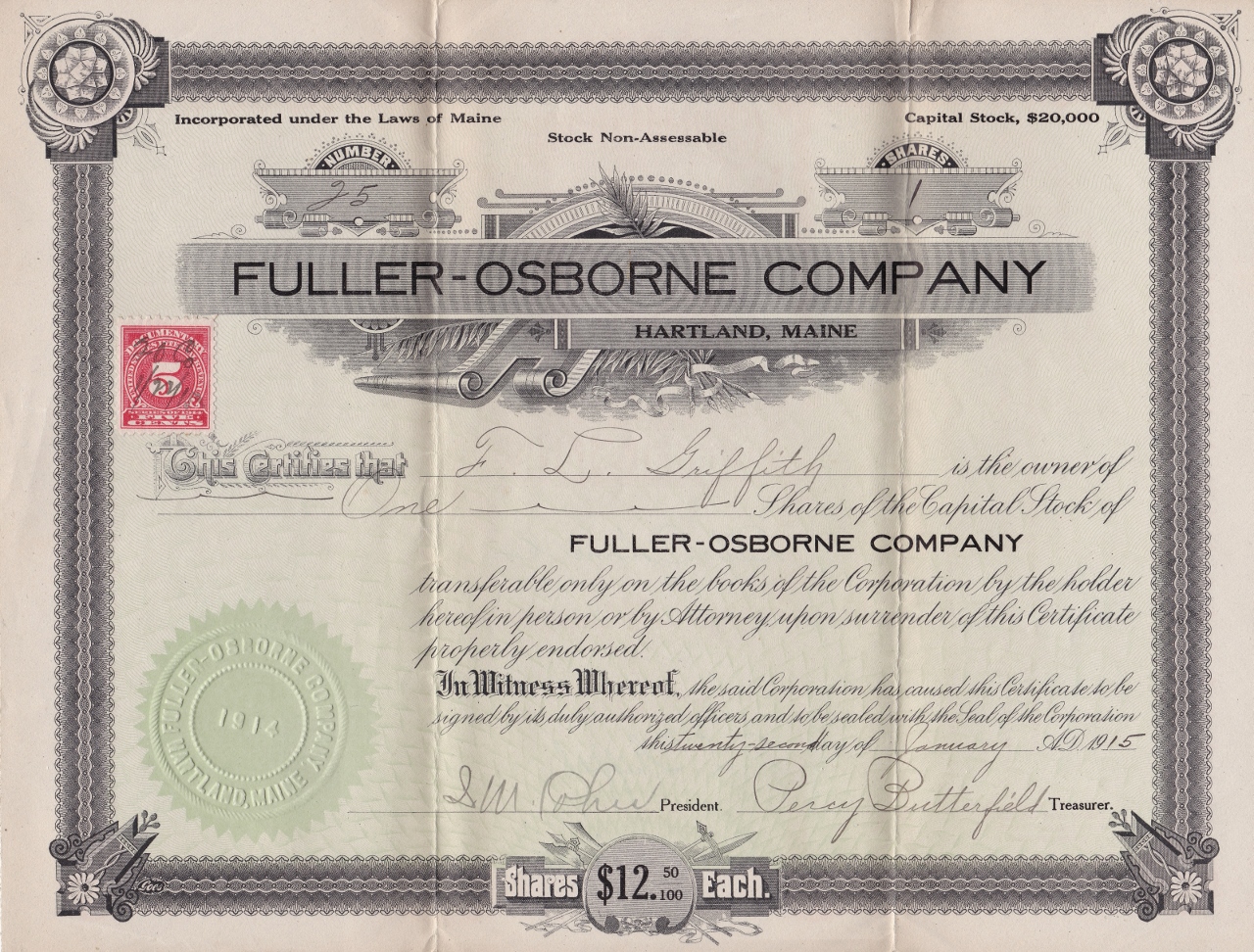
Fuller-Osborne Company Stock Certificate purchased by Frank Lee Griffith – January 22, 1915
(Donated by the Griffith Family)
*
The original embossing tool used by Fuller-Osborne Company for their stock certificate purchase validation.
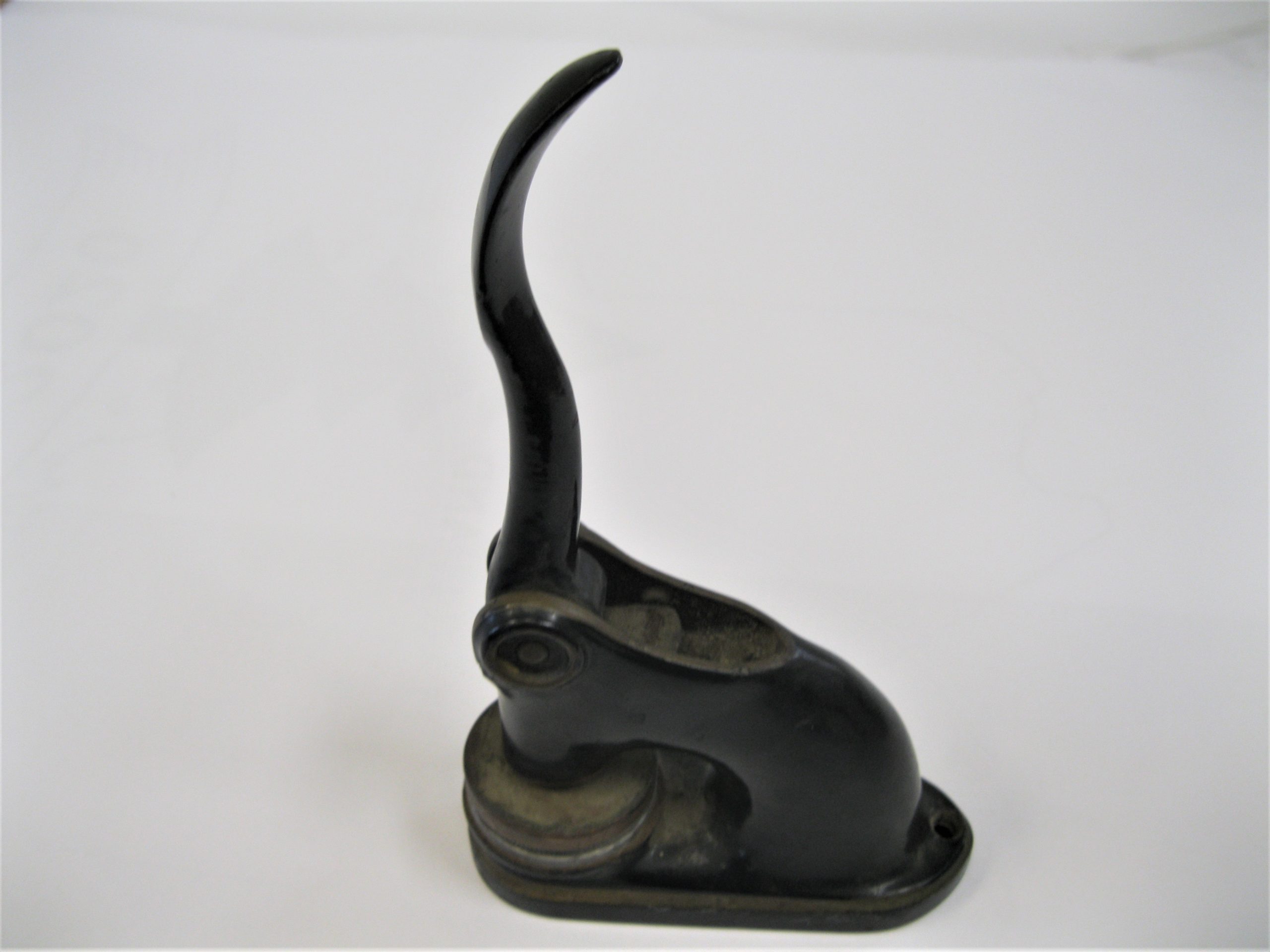
Fuller-Osborne Company Stock Certificate Embosser
(Photo courtesy of Joe & Christine Lewis)
*
100+ years later, the original embosser tool still leaves its clear and distinguished imprint.
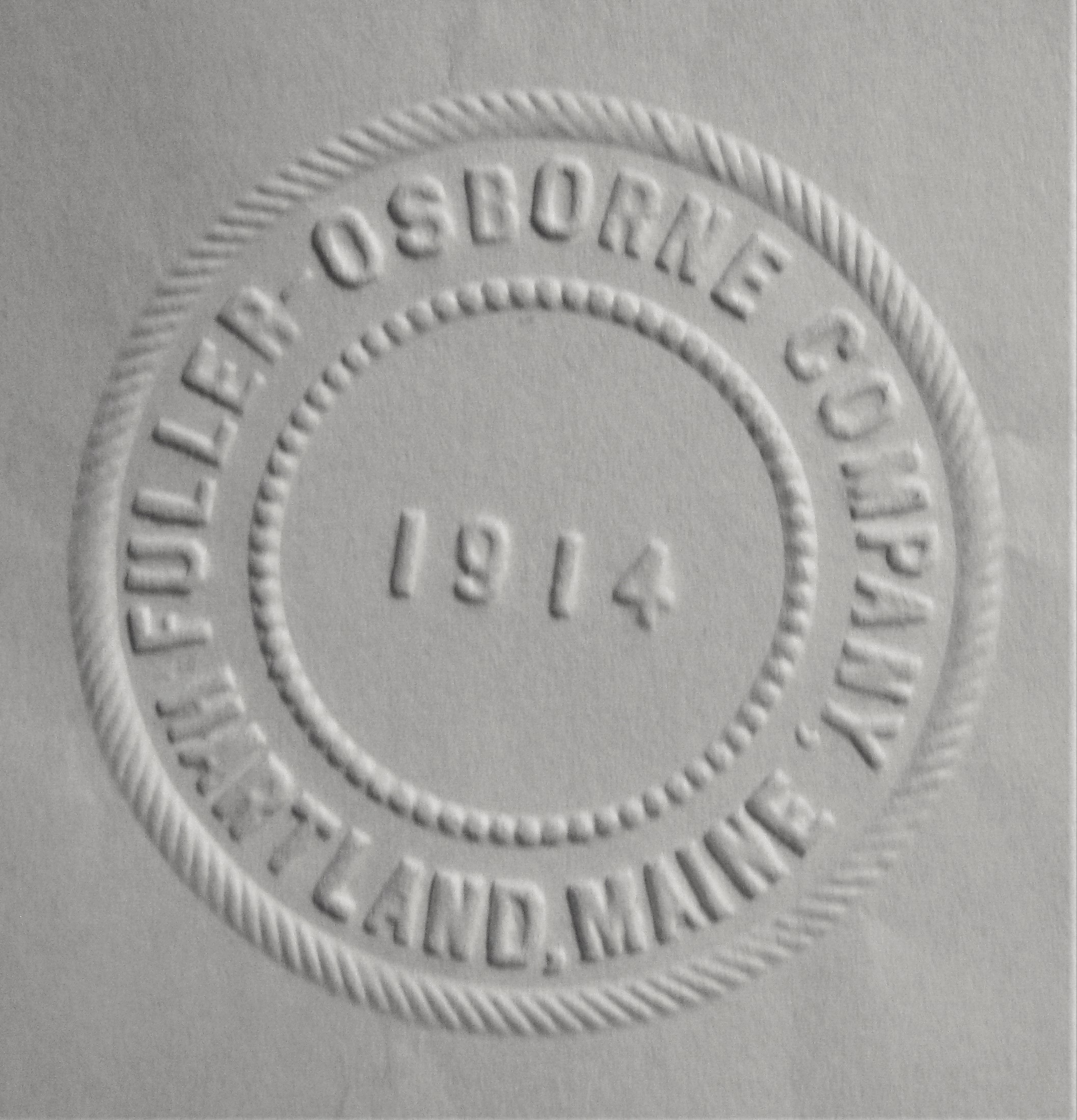
Embossing Tool Imprint – Made in 2021
*
With the end of the Linn Manufacturing Company, the American Woolen Company, which had been buying up numerous other woolen mills in the area, leased the Linn Woolen Mill buildings in 1915 and began a new era of wool production and employment in Hartland. Its story is continued on the American Woolen Company page.